Deconstructing Fortnite: A Deeper Look at the Battle Pass
Cross-Posted from Deconstructor of Fun. Co-wrote with Joseph Kim.
It’s hard to go a day without hearing about Fortnite anymore. In February, Fortnite passed PUBG in total revenue on PC and console ($126M versus $103M). While PUBG (Player Unknown’s Battlegrounds) started a movement, Fortnite created a phenomenon.
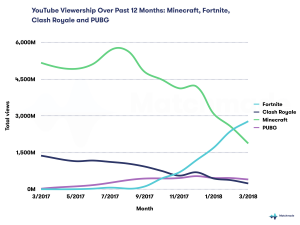
Fortnite is by far the most viewed and streamed game on YouTube. source: Matchmade.tv
However, while the Battle Royale genre continues to heat up, I’d like to focus on a specific topic: the Battle Pass system as the monetization driver. Fortnite, for all of its smart decisions and flaws, made one key choice months after its launch: it wasn’t going to monetize based on loot boxes, instead, it was going to monetize off of its Battle Pass system.
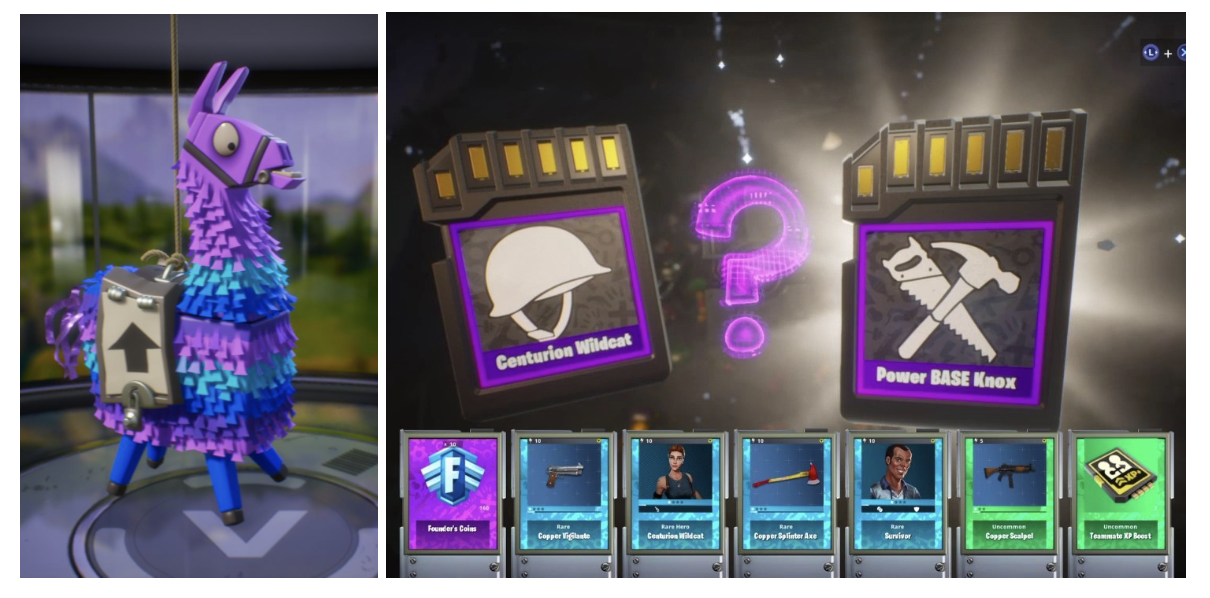
It’s not as if Epic hadn’t thought of making it a loot box driven economy — Fortnite’s own “Save the World” mode is a loot box driven economy which you buy llama-themed pinatas that contain random gameplay-impacting items. Yet for their Battle Royale system, they chose to go against this.
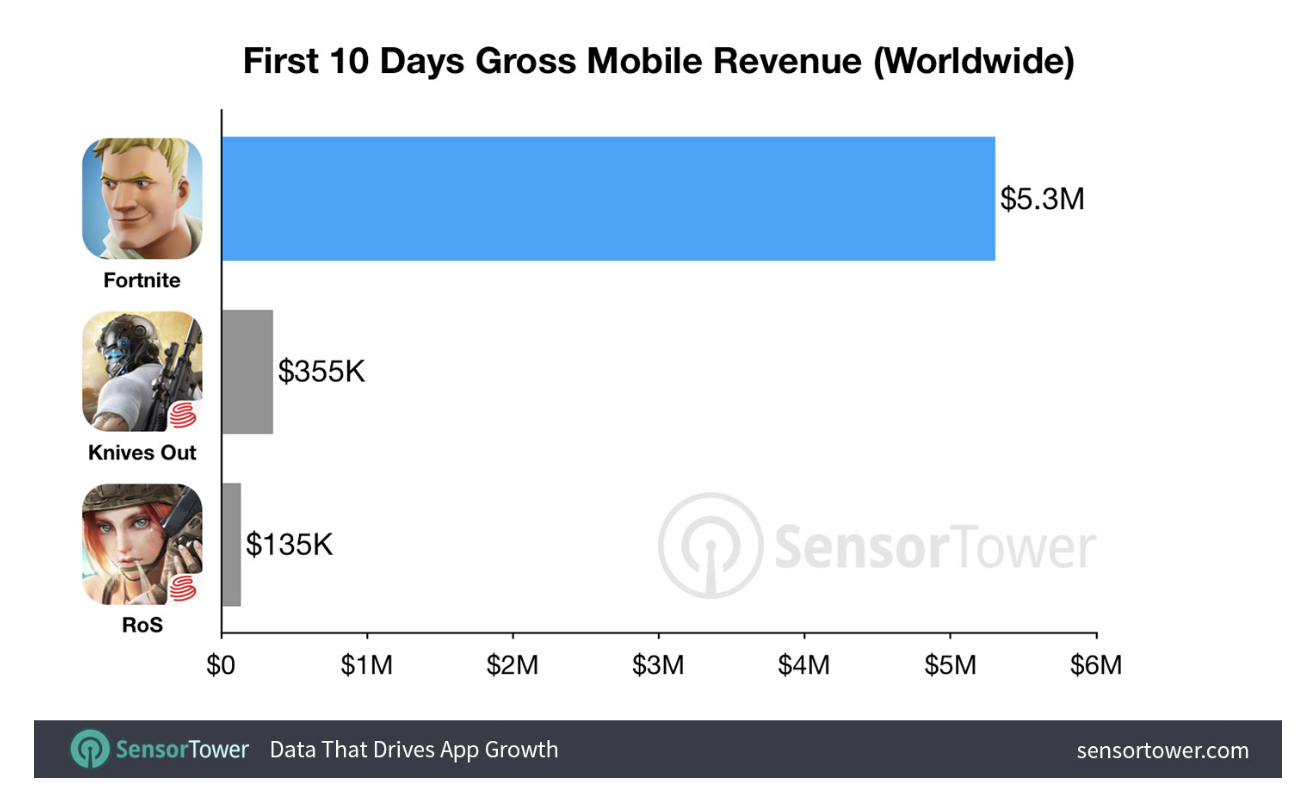
Regardless of what you think of the choice — Fortnite’s revenue shows they’ve done something right. Fortnite has been steady as the top grossing game on mobile for weeks now, demolishing traditional mobile free-to-play titles, and outpacing all other battle royale style games on mobile in both downloads and revenue. The fact that the game was invite-only for the first weeks or so makes the feat even more impressive.
However, these results beg a question: is the revenue coming simply because of the user base size (DAU), or does the Battle Pass system actually drive higher revenue-per-user than a loot box system? In terms of KPIs, we’d be comparing ARPDAU or ideally, LTV.
While no one but Epic can peek behind the curtain and see what their metrics are, we will speculate today!
Fortnite’s Cosmetic-Driven Economy
Much like in MOBAs, Fortnite’s progression and monetization only come from cosmetics. Fornite is a “free-to-win” model: they do not sell anything that could impact the balance of the battle royale gameplay. All guns, armor, ammo is scavenged in the battle royale gameplay, but a player can choose what cosmetics they want to bring into a match.

Fortnite allows you to select a number of cosmetic options to bring into battle:
- A Skin/Outfit your character wears
- “Back Bling” — or a knapsack
- Harvesting tool — a Pickaxe is boring, why not a Scythe?
- Contrail — what Glider you use while falling (gotta look cool while falling)
- Loading Screen — what loading screen you see (only for yourself)
- Emotes to communicate with others. (you can bring in 6 emotes which you can trigger)
Since progress isn’t made through traditional stats and level up, the only way to show off your progress is through cosmetics. It’s not pay-to-progress, it’s pay-to-look-cool.
Until Fortnite, cosmetics-only based mobile games have not been able to achieve strong overall revenue, at least in Western markets. Although the large revenue growth certainly derives strongly from a massive number of installs, the amount of revenue and the #1 top grossing status cannot be explained without a level of monetization heretofore unseen by cosmetics in Western markets on mobile.
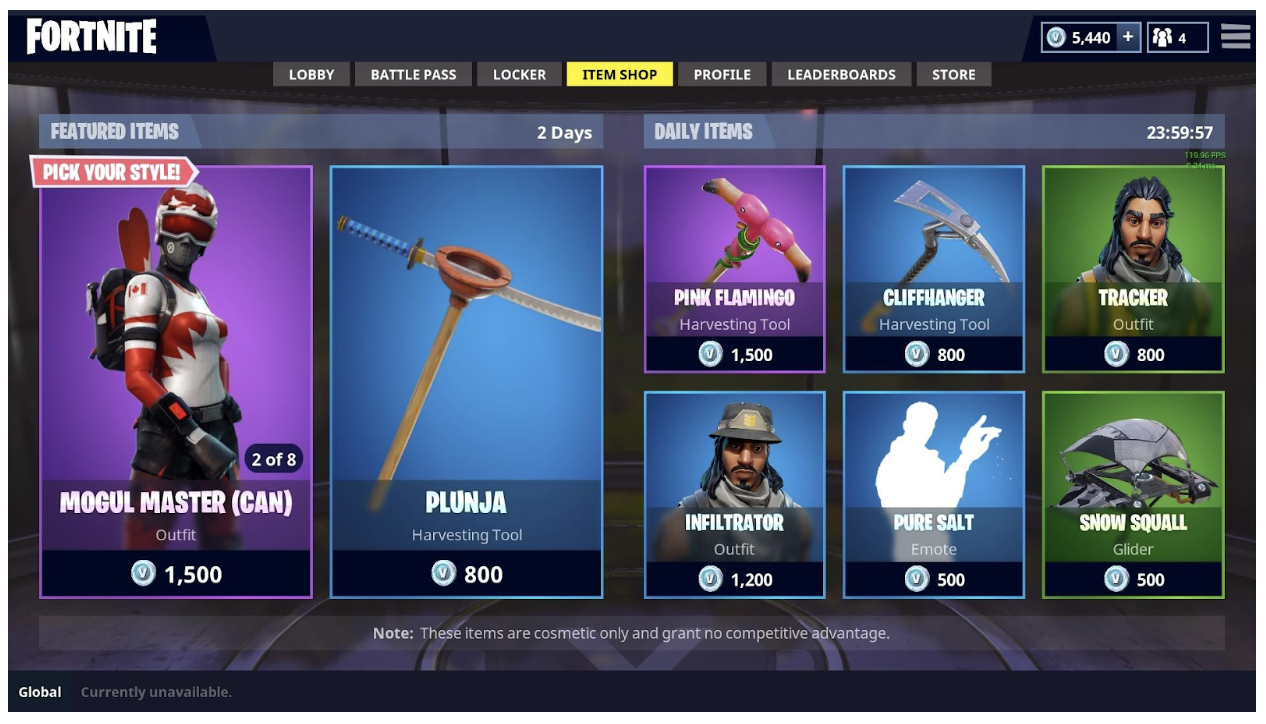
With the cosmetic driven economy, rather than dropping new cosmetic gear through gacha/loot boxes (like Overwatch, Destiny, etc.) cosmetics are either purchased with V-bucks (premium currency) or earned through the battle Pass. Interestingly, directly purchasing cosmetics through the shop has limited access. Each day there is a limited selection of items to purchase, so while loot boxes aren’t included in the economy, there is a limited set of items that are available at any time. Great for driving players to check the shop out daily, and giving additional pressure to purchase items while they are available.
The Battle Pass
Besides being able to purchase cosmetics with premium currency, players can also play and earn cosmetics and consumable boosts by completing their Battle Pass.
The Battle Pass is a set of rewards which can be unlocked by completing challenges. Completing challenges rewards the player with XP, which increases your tier, which unlocks subsequent rewards. The challenges themselves range in difficulty but give a baseline of progress for the Battle Royale style game.
When playing a Battle Royale game, especially if you’re not skilled, most games will end up with getting shot and losing all your progress. Also in many battle royale games there can be times when you’re waiting around for other players to arrive. These challenges give players additional goals to think about while playing, and can make even a losing round feel like progress.
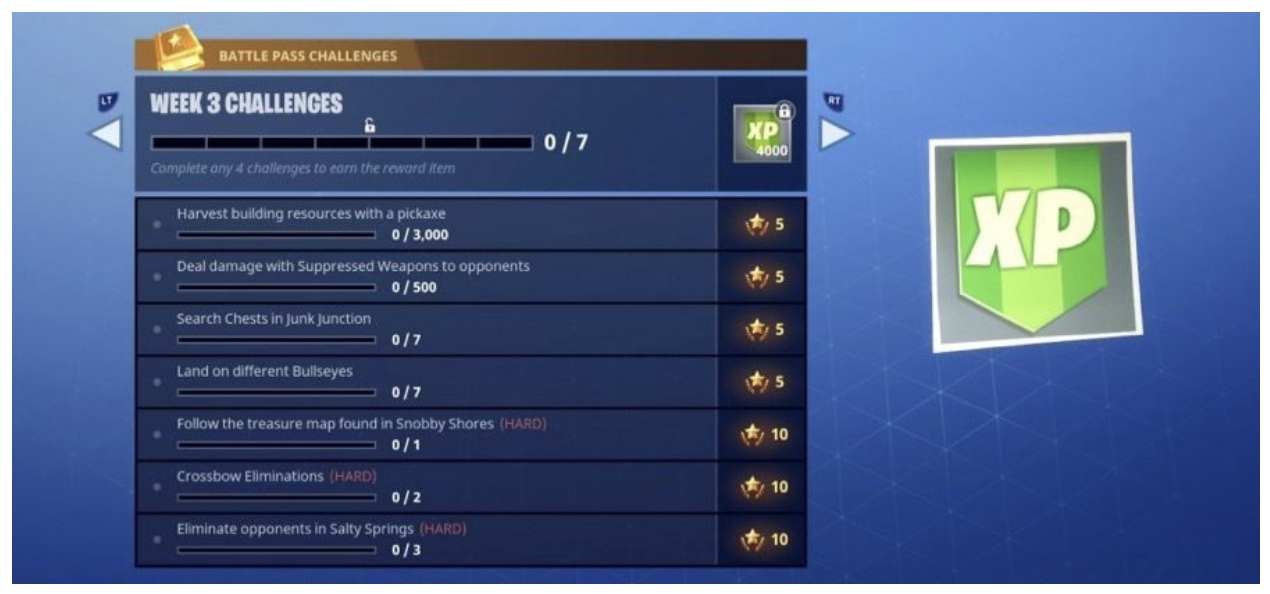
The monetization comes in with the free vs premium tracks, much like the VIP system in Wargaming’s World of Tanks (read the full deconstruction of World of Tanks). Free players get far fewer rewards than the premium tier. Creating a very clear conversion effort. Look at all the stuff you “earned” but didn’t receive! The amount of content given out for the premium tier is compelling — its generous in terms of the payoff and pays back your effort quickly. This feels very similar to Annuities or “Subscription Diamonds” in mobile games. A small price that pays out far more than it costs – but only if you engage in the game.
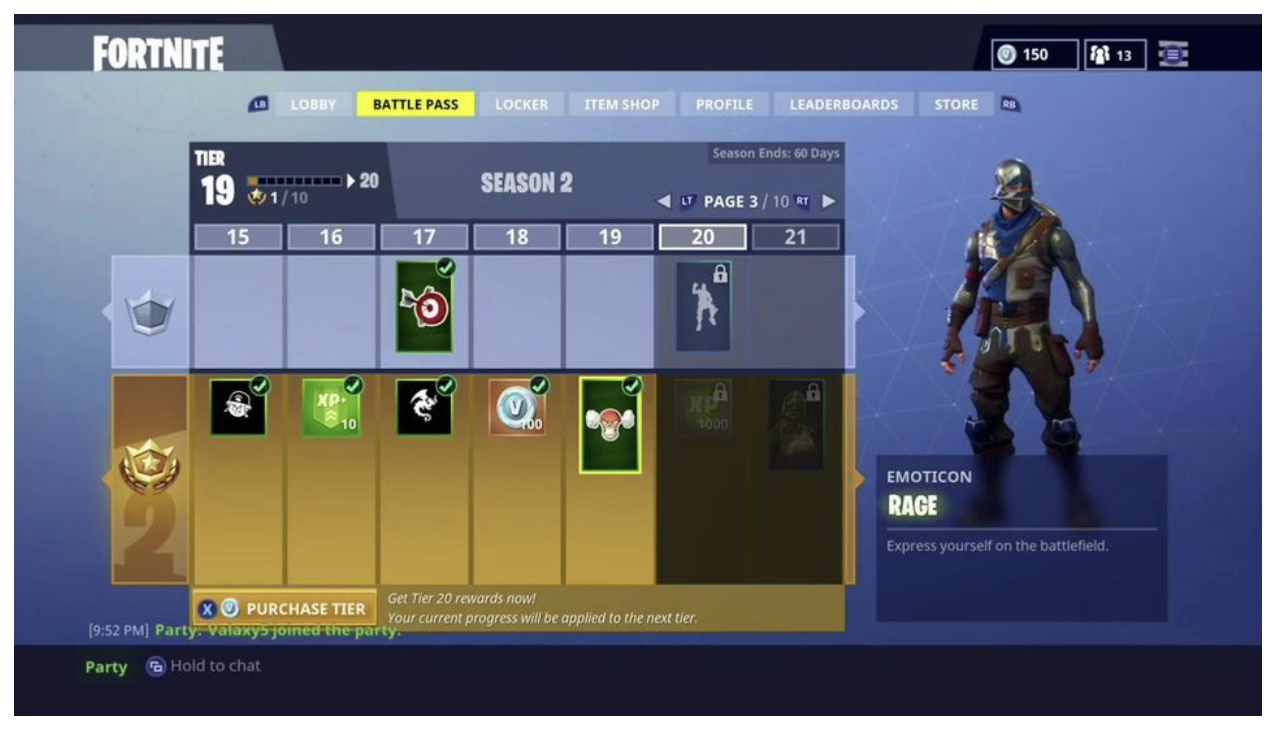
The Battle Pass is limited to a season, which is what makes it so compelling. Each season has a matching Battle Pass, which comes with its own set of cosmetic content and rewards. If you don’t complete the battle pass in time — you don’t get the content. Some content may come in and out of the store on a daily basis — but then it’s usually for high costs of premium currency.
There’s a big “Fear of Missing Out” feeling with this system.
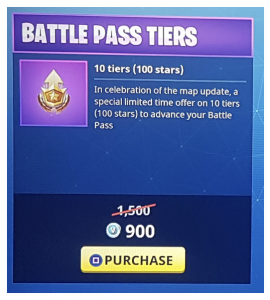
If being able to directly purchase progress was in any other game, most free-to-play designers would shoot this down. It’s usually a far better idea to monetize players on the gameplay itself and not allow players to directly pay to skip. It would feel very pay-to-win if you could directly pay to reach the top arena in Clash Royale, or pay to skip a set of levels in Candy Crush.
However, since Fortnite can’t really monetize on the core gameplay, and this is really just paying to reach cosmetic content (your battle pass tier isn’t really a metric player compare as a sign of skill) — player’s don’t seem to mind, and their revenue isn’t impacted. Player’s have a way to pay-for-progress to the cosmetic items they want.
Want a head start on the season so you can show off the cosmetic items before your friends get there? Pay to skip ahead!
A week’s challenges or season coming to a close and you don’t have time to get all the remaining challenges? Pay to skip ahead!
For this reason, the spend depth and potential of the battle pass system shouldn’t be seen as limited to just the monthly purchase price. When a player has locked into the battle pass, they are more likely to be highly engaged that season to unlock the content and to convert on skipping ahead to get all that content they unlocked.
User Experience of Battle Pass vs. Loot Boxes
Battle Pass can be best described as a system first and foremost for retention and player experience. Comparing Battle Pass to Player Unknown Battlegrounds (PUBG), it gives players real goals, a direct sense of progress, and a clear path to the cosmetics that they want. PUBG instead uses a loot box system to gate all of their cosmetic content. Players play a match, get as many “Battle Points” (BP) as possible, to eventually open up a loot box.
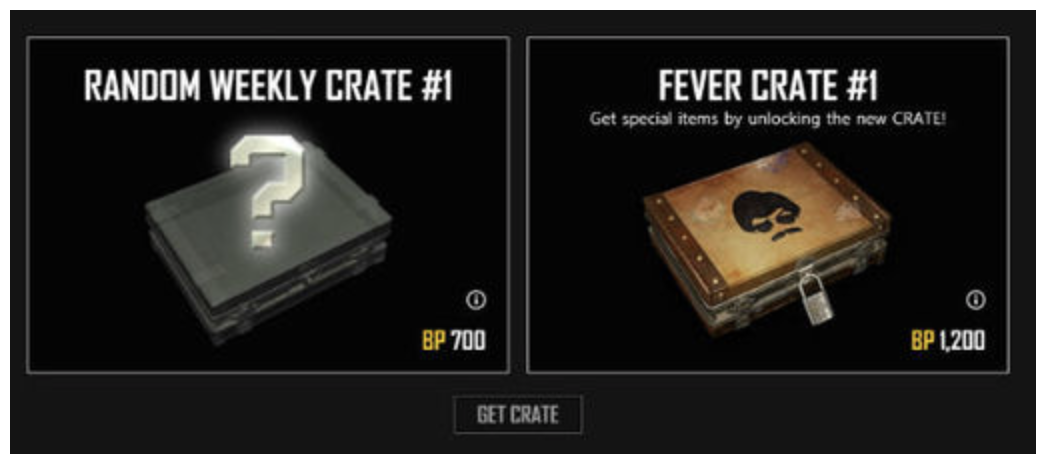
These loot boxes can sometimes be locked with a key that needs to be bought with real money, which feels pretty much like a blatant rip-off. Like most gacha systems, as a player, this means the path to desired content is completely luck-driven. You can’t even save your BPs or a dust-like currency (example: Credits in Overwatch, or Dust in Hearthstone) to eventually get the item that you want. You just need to get lucky.
From a player’s perspective, Battle Pass simply feels fair compared to the competitors gacha systems.
So overall, from a player’s perspective, Fortnite’s Battle Pass system is a great match for battle royale:
- It gives secondary goals which give a strong baseline of progress and can keep the game interesting
- It gives players a clear marker of progress through a season and a goal of what to accomplish besides just killing every round
- It’s a compelling conversion item + retention driver. The amount of content for the price and the clear visual of seeing content that you “earned” but can’t access is a compelling driver to both monetize and engage in the game.
- It creates an endowment effect of purchasing an item but only being able to unlock the content if you engage highly in the game
But it’s not as if this Battle Pass system came from nowhere, it’s obviously inspired by the playbook of Valve’s DOTA2. Their compendium battle pass has been a staple of that game since 2013. Looking at Valve’s evolution of the compendium, you can see potentially how this system will evolve in Fortnite.
The Benchmark: DOTA2’s Battle Pass
Started in 2013 as an incentive for players to donate & get interested in the e-sports scene of DOTA2, the compendium was essentially an interactive guide to an upcoming tournament. Similar to a guidebook you’d get at a sporting event: it told you about the players, tracked the stats, and got you interested in the game itself. Valve doubled down on this by making it digital, interactive, and gave a portion of the money raised by the compendium as part of the prize pool. Players had a way of supporting the esports scene for their favorite game.
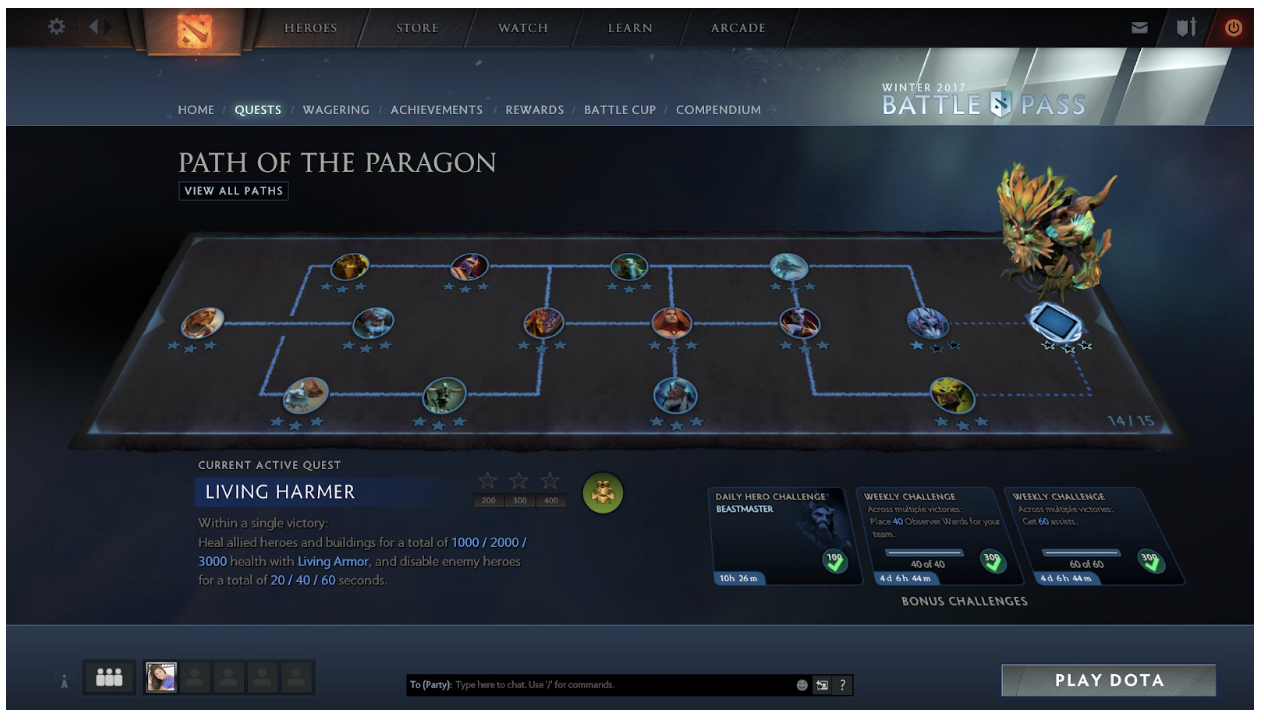
This has since evolved quite a bit. What started as just a compendium turned into a battle pass. They eventually added goals for players to accomplish in PvP that would increase their level for that season, and unlock cosmetic rewards (just like Fortnite’s today). However, DOTA2 has gone far deeper, with a number of recent additions that significantly increase the depth of the system.
- Multiple Paths give players choices as they progress in the battle pass, giving far more goals in parallel for advanced players. Also, give further reason to reach higher levels in the battle pass (some paths only unlock when you’ve reached a high enough level).
- Unlimited tiers with content unlocking slower and slower over time. Whereas Fortnite is capped at 100 tiers of content, DOTA2 has unlimited. This creates situations where players are even competing against each other to see who can progress farther in a season (when the competition itself is directly pay-to-progress)
- Treasures/Loot Boxes as rewards rather than direct cosmetics. This gives players a mix of direct rewards and a chase to get the random rewards that they want.
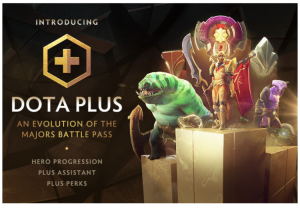 So while Fortnite’s Battle Pass system may just be in its “early access” phase right now with a basic feature set, it’s clear that Epic is taking inspiration from Valve’s similar Battle Pass system. This evolution shows that the current implementation is not just limited to 100 tiers of content, but could be a far longer lasting and complex chase which could drive even higher retention and monetization. This system clearly has been successful for DOTA2, since recently they’ve started to shift the system to a full-on subscription style service called “DOTA Plus”. Little details are known at this point, but it looks to be replacing the Battle Pass with an ongoing subscription that gives even further systems and progression.
So while Fortnite’s Battle Pass system may just be in its “early access” phase right now with a basic feature set, it’s clear that Epic is taking inspiration from Valve’s similar Battle Pass system. This evolution shows that the current implementation is not just limited to 100 tiers of content, but could be a far longer lasting and complex chase which could drive even higher retention and monetization. This system clearly has been successful for DOTA2, since recently they’ve started to shift the system to a full-on subscription style service called “DOTA Plus”. Little details are known at this point, but it looks to be replacing the Battle Pass with an ongoing subscription that gives even further systems and progression.
But comparing the Battle Pass system to a pure-gacha system, is Fortnite (and potentially DOTA2) leaving money on the table? While it’s obvious that its a play for stronger retention and higher conversion, is the lower spend depth hurting them?
Is the tradeoff of giving away all this cosmetic content for higher conversion really the smartest business decision?
Revenue Analysis of Battle Pass
Just how impactful is Battle Pass to monetization? More specifically, we should ask this question on two levels of scope:
- Battle Pass vs. Cosmetics: How does Battle Pass monetization compare to other forms of cosmetics based F2P, mobile monetization?
- Battle Pass Overall: How does Battle Pass monetization compare to F2P, mobile monetization overall (including pay-to-progress models)?
We can get a rough sense for both of these questions by doing some high-level comparison. In particular, we can a) compare monetization of the various “fair-to-play”, cosmetics driven Battle Royale games and then b) compare monetization with “pay-to-progress” game monetization schemed games.
As an initial investigation let’s take a look at lifetime average revenue per install (ARPI) of each of these titles based on Sensor Tower data to comparative, key high-performing titles:
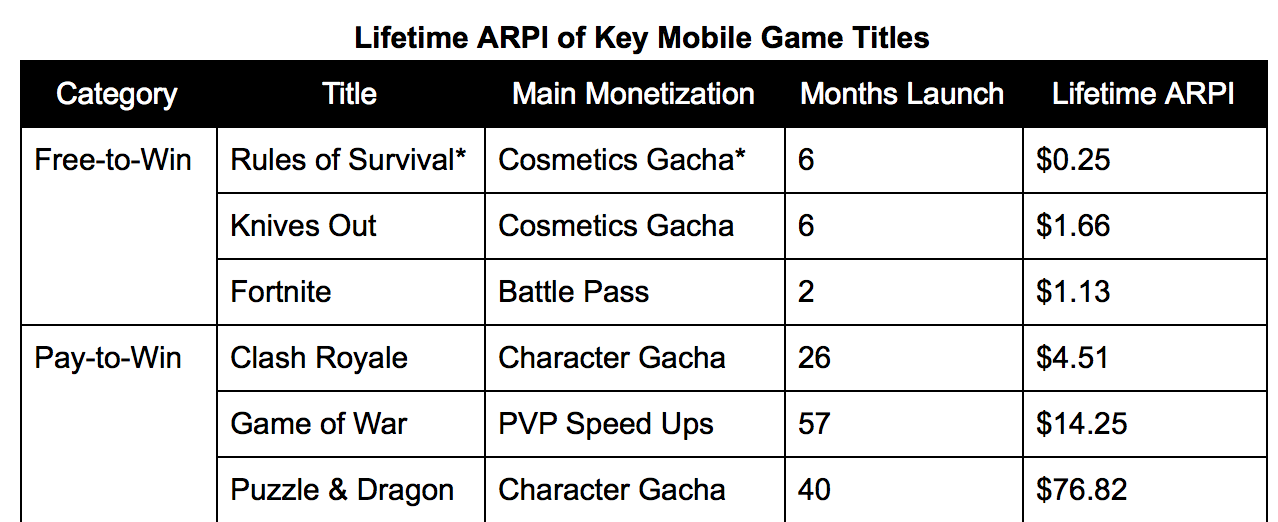
*Note: Rules of Survival does contain some weapons in its loot box, while they are balanced it is not strictly a cosmetics gacha
Source: ARPI based on Sensor Tower data
Battle Pass vs. Cosmetics
Let’s now address the first monetization question we posed above: How does Battle Pass monetization compare to other forms of cosmetics based F2P, mobile monetization?
At first glance, it would seem that Knives Out has the best per user monetization (ARPI) of the Fair to Play games. However, two issues are not fully captured by the chart above:
- ARPI growth over time and
- Audience distribution.
#1. ARPI Growth Over Time
Note the number of months in launch in the Lifetime ARPI chart above. Generally speaking, the longer a game sits in launch, the better the game’s ARPI becomes (eventually achieving it’s LTV):
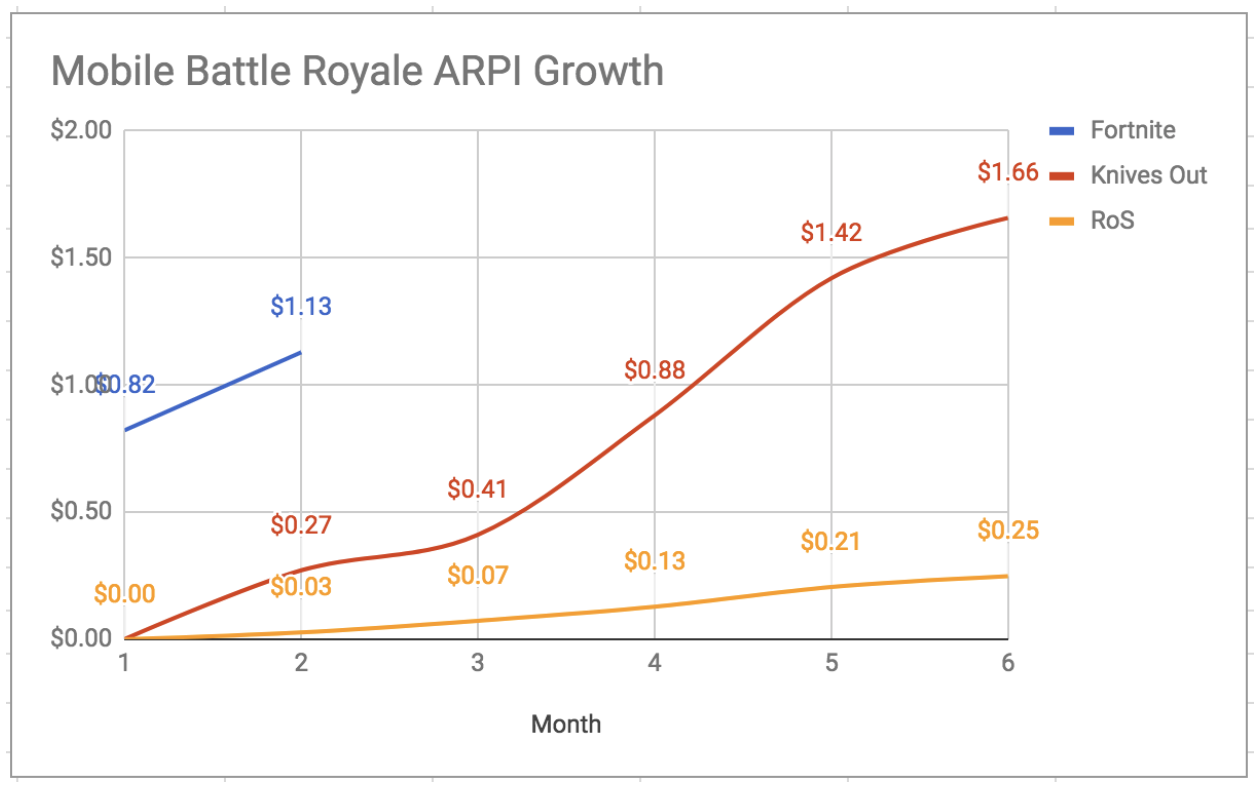 Source: Based on SensorTower Data
Source: Based on SensorTower Data
Note the number of months since launch in the lifetime ARPI (avg. revenue per install) chart above. Generally speaking, the longer a game thrives in live operations, the better the game’s ARPI becomes (as the installs decrease and existing users spend more during their lifetime):
#2. Audience Distribution
The other key driver for monetization for Knives Out is it’s audience. Japan *generally* monetizes much more strongly than other countries, often 2x+ that of US. Hence, the large concentration of Japanese users in Knives Out primarily drives the monetization gap between Knives Out and Rules of Survival.
You can see the revenue split by top 5 countries for all three of the games below:
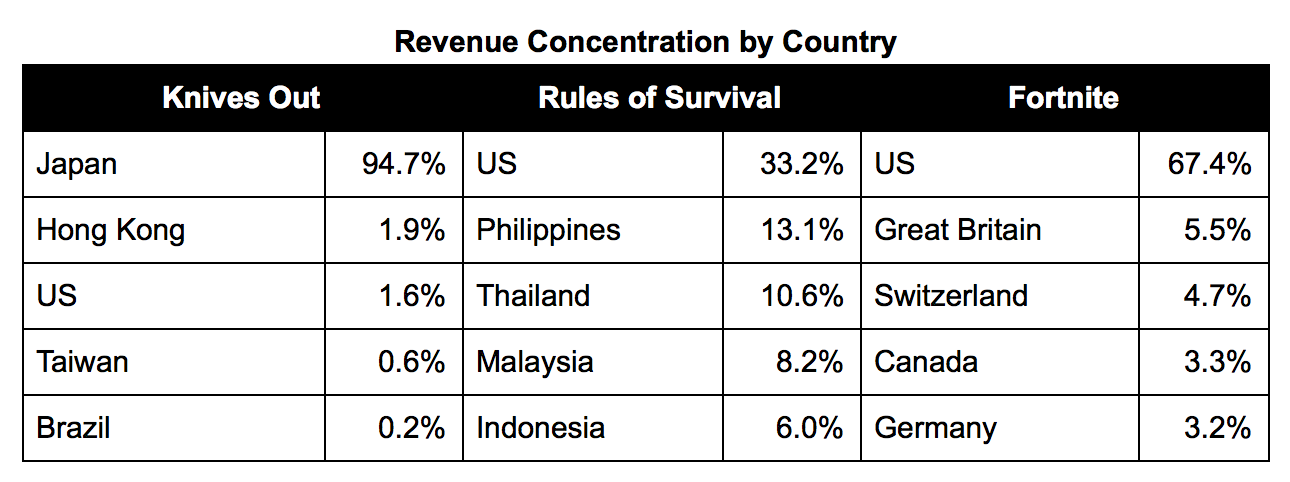
Source: SensorTower
So what happens to monetization if we were to exclude Japan?

Wow, what a difference a country makes! Without Japan, Knives Out actually becomes the worst performing game in term of monetization. Somehow Fortnite per user monetization actually does better without Japan.
Battle Pass vs. Mobile Free-to-Play
Let’s now address the second question we posed regarding Battle Pass monetization earlier: How does Battle Pass monetization compare to F2P, mobile monetization overall (including pay-to-progress models)?
From the Lifetime ARPI chart, it would seem to indicate that more traditional F2P monetization mechanics such as gacha or PVP speed-ups are much more effective on a per-user, unitary level than cosmetics based monetization.
However, we should also take two factors into consideration:
- Months to LTV: How much further can a cosmetics driven monetization last over time?
- Downloads vs. ARPI: Although ARPI for “free-to-win” games may not be as high as other, more traditional F2P monetization mechanics, these games should generate higher install volumes based on the friendlier monetization scheme.
Let’s discuss both of these points in turn.
#1. Months to LTV
So how long can gacha based games continue to increase ARPI until it hits LTV? Unfortunately, we only have 6 months of data on Rules of Survival and Knives Out and less than 2 full months for Fortnite.
One way to estimate the ARPI growth is to just do a logarithmic trendline and extend out the timeframe to say 20 months.
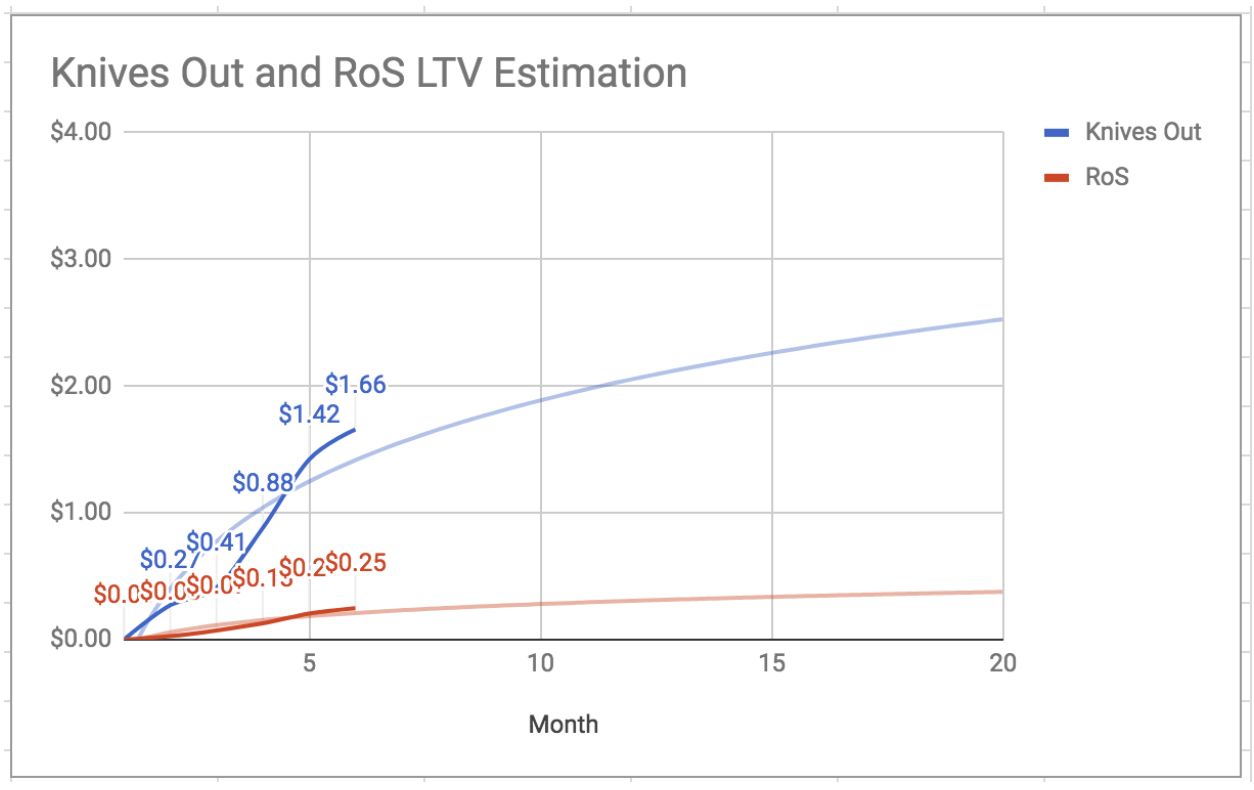
Another way we could guess the eventual LTV of these games is by taking a look at other game examples such as Clash Royale:
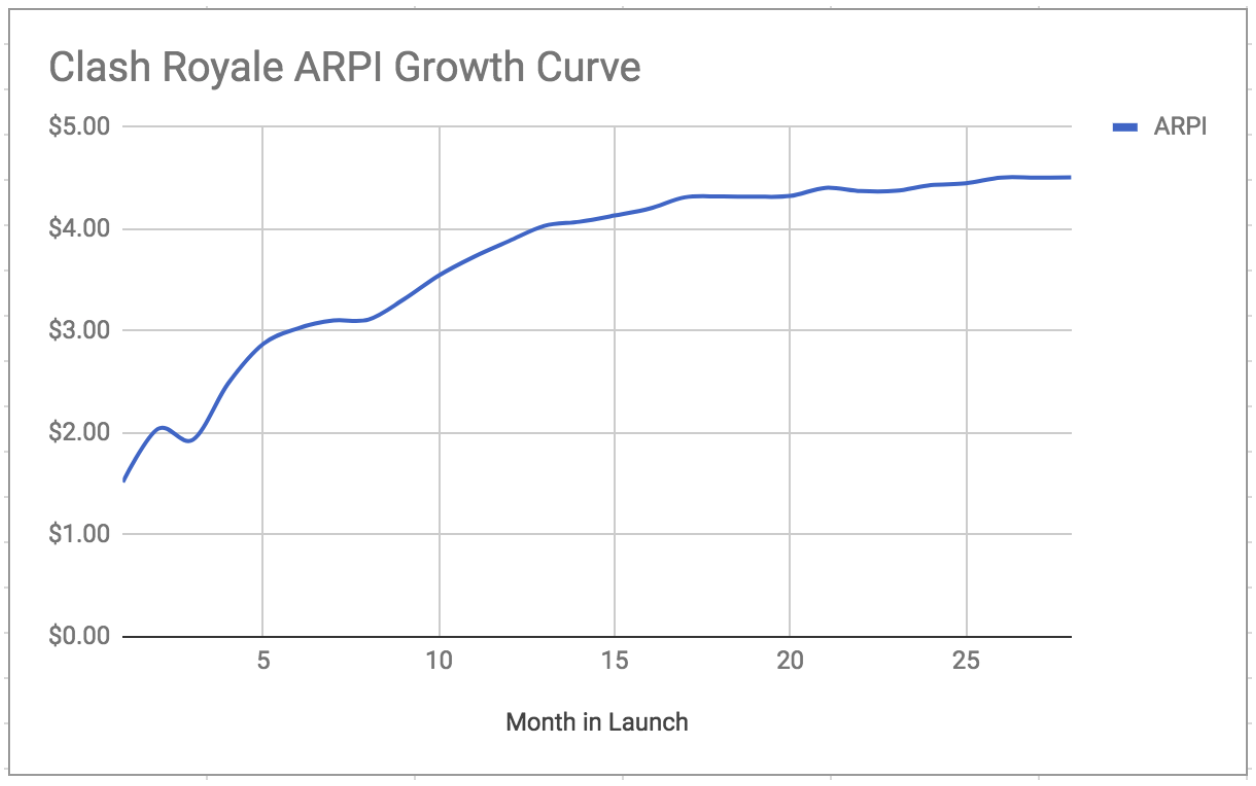
Source: Based on SensorTower data
Based on the above ARPI growth continued for at least 15-20 months. Hence, the 20 month timeframe for our logarithmic trendline earlier.
Traditional F2P designers would typically assume that cosmetics driven monetization should hit their LTV ceiling much sooner than a well-designed gacha game.
However, for the sake of simplicity, and just to get a rough feel let’s assume that the fair-to-play game monetization will follow a similar trajectory. In fact, let’s just eyeball all of this pretty roughly to estimate LTV.
Assumptions based on a rough eyeballing of Clash Royale ARPI growth:
- RoS/Knives Out will increase another 50%
- Fortnite to increase by 125%

On the face of it, Knives Out and Fortnite would have similar long-term LTV estimates based on our analysis above. However, when we factor in audience concentration, we can conclude that Fortnite has much stronger monetization design. This was clearly shown when we excluded Japan from our monetization data earlier.
#2. DL vs. ARPI
Although we’ve focused so far primarily on unitary economic measures like ARPI, at the end of the day, what matters most will be the amount of overall revenue (and profit) a game can generate. Hence, in addition to ARPI/LTV we must also look at product level economics by also looking at downloads and in turn overall revenue.
As you can see from the chart below, while free-to-win based monetization has not performed as well on a per player basis, but overall revenue can be quite healthy even compared to top pay-to-progress types of games.
Also note that we only have less than 2 months of data for Fortnite (so it’s not an apples-to apples-comparison), and it has been limited by a number of issues such as being iOS only and having high-end device requirements.
Further, Clash Royale, unlike the other titles, leveraged one of the strongest IPs in mobile gaming and utilized massive user acquisition to help drive stronger install volume for their game.
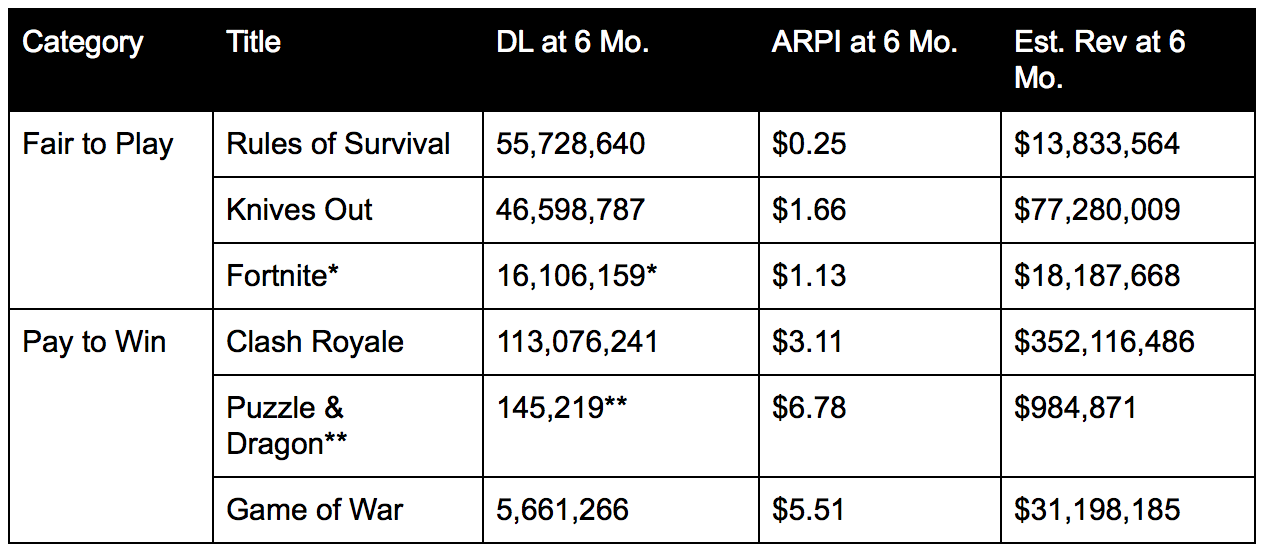
* Less than 2 months of data only and currently only on iOS
** Puzzle & Dragon started off in Japan only
Source: SensorTower
Battle Pass For the Win!
So, what is our conclusion on the original monetization questions we posed with respect to Battle Pass?
While pay-to-progress style economies will certainly drive higher per-player revenue, for games that monetize off cosmetics the battle pass is certainly showing impressive results. Battle Pass will likely become a dominant monetization system used with cosmetics based monetization in the future. Not only can it provide far better player experience, but by a rough calculation, it shows that it can drive higher LTV.
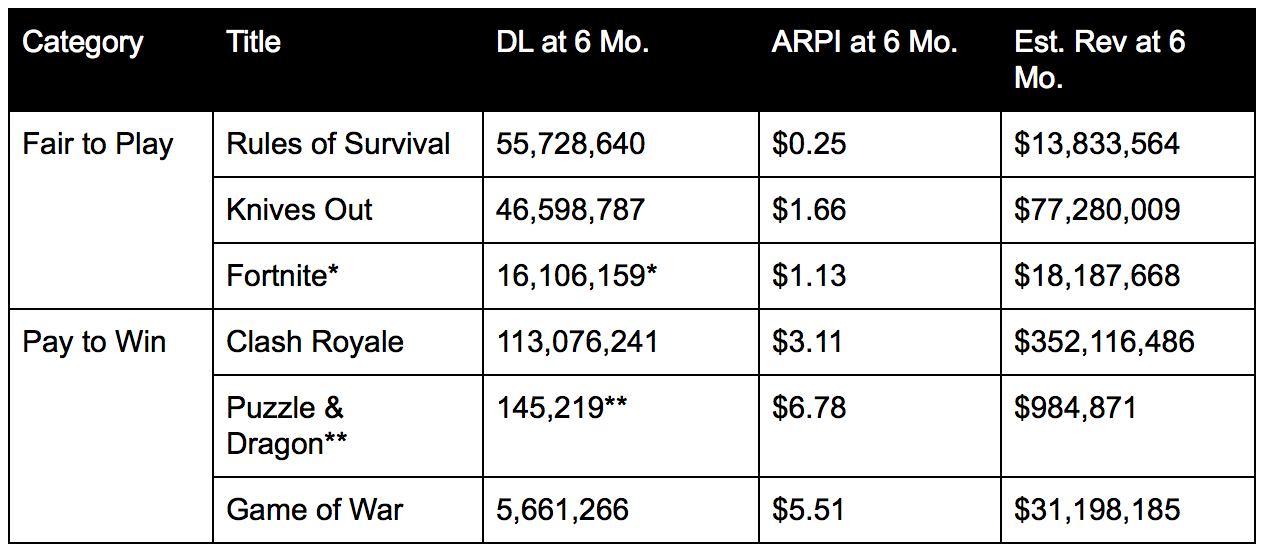
Just keep in mind these calculations are rough – these are using estimates of revenue and downloads, we’re using trendlines based on a small set of data, and we’re looking at a game that didn’t start from scratch when launched on mobile. The legion of fans that came over from PC/Console area already highly engaged and used to its systems. We’ll need to see how this goes in the coming months!
Yet by these rough calculations, we’re pretty excited. A player-friendly system that gives better goals and drives higher engagement shows the path to stronger revenues. All the while Valve’s DOTA2 shows that this is just the MVP of a battle pass system. Bringing in a hybrid of gacha design and a deeper battle pass will most likely be the future for cosmetic driven games.
Exciting times ahead!
Deconstructing Splatoon’s Metagame Design
What does Splatoon, a paid game for consoles have to do with mobile free to play?
Well, you can find inspiration and clever design in any medium. Just so happens I’m a massive fanboy of Nintendo, and after playing their game for months it was inspiring to spot some really interesting design bits that can be applied to any free-to-play game.
Just to give you some background, Splatoon is a multiplayer 3rd person shooter for Wii U.
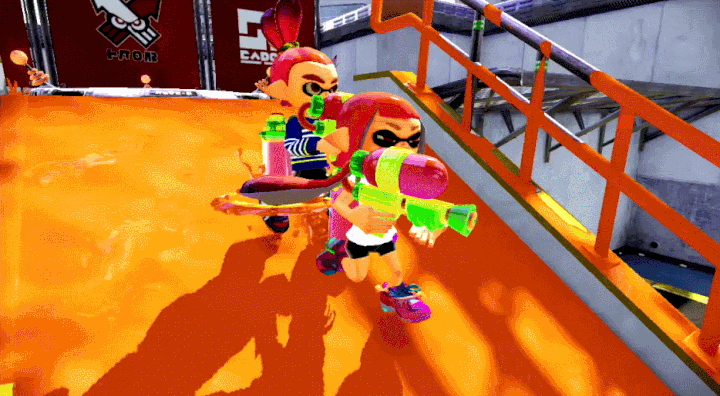
Splatoon of course isn’t just your run of the mill shooter however. Nintendo re-invented this genre from the ground up. The focus isn’t on kills, instead it is on covering the arena with as much of your team’s colour as possible. Kills can help slow down the opposition, but it is more about controlling territory than it is about camping for kills. As a result the game feels much more casual for players that aren’t interested in getting headshots, yet strategically deep for players that want to compete.
The core gameplay aside though, Nintendo did something I don’t think many designers expected. They built a masterful metagame outside the battle which drives strong long term retention. Instead of just taking the tried and true Call of Duty perk & leveling system, they’ve built something that feels great and keeps players coming back. This is something that all F2P games strive for.
Today I’d like to focus on 2 mechanics in Splatoon that can be applied to any F2P game:
#1 Splatoon Clothing
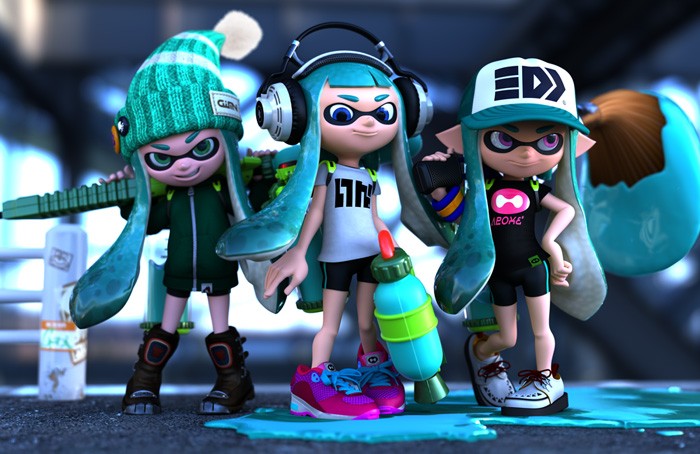
The part that binds the entire metagame together for Splatoon is the clothes. Nintendo’s design of how players get clothes, unlock clothes and level up clothes makes this game work. It makes this game last.
Nintendo could have decided to go with the tried and true method that many shooters and skill based games go with. Call of Duty pioneered a system in 2007 which many online focused games have used since. Players gain levels by playing games and gaining XP. Levels unlock new guns, new perks and new gadgets to play with in the multiplayer game. As you progress up the levels you’re rewarded with more options to choose from. This system is simple and effective, which is why most multiplayer games have used this method over and over.
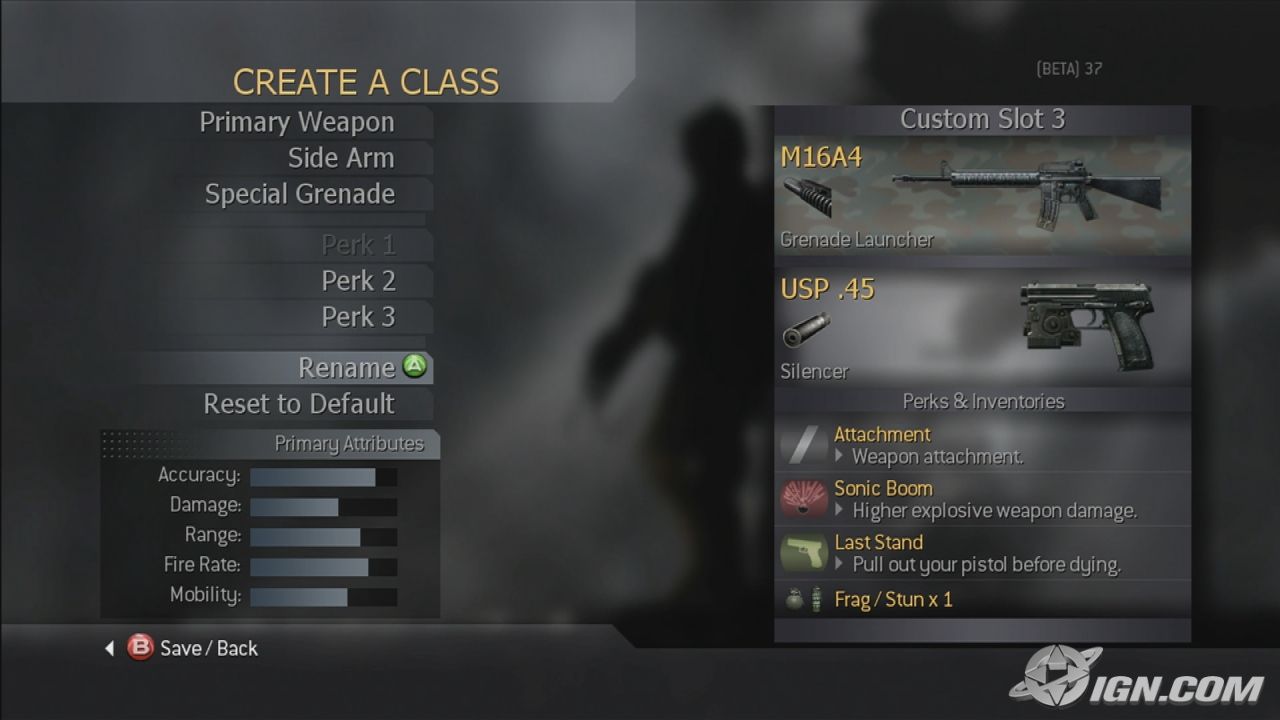
The original system that everyone uses. Levels unlock new options for the player.
But this Call of Duty system also has its disadvantages. Each player unlocks equipment and upgrades in the exact same way. So while it allows players complete flexibility in choosing their loadout, there’s very little choice in the grind. Players just seek to optimize their XP growth.
Splatoon approached this in a completely different way. Splatoon instead ties perks and abilities to clothes. Instead of players being able to freely decide which perks they want, players need to choose clothes, upgrade them, and hope that they contain the perks and abilities that they want.
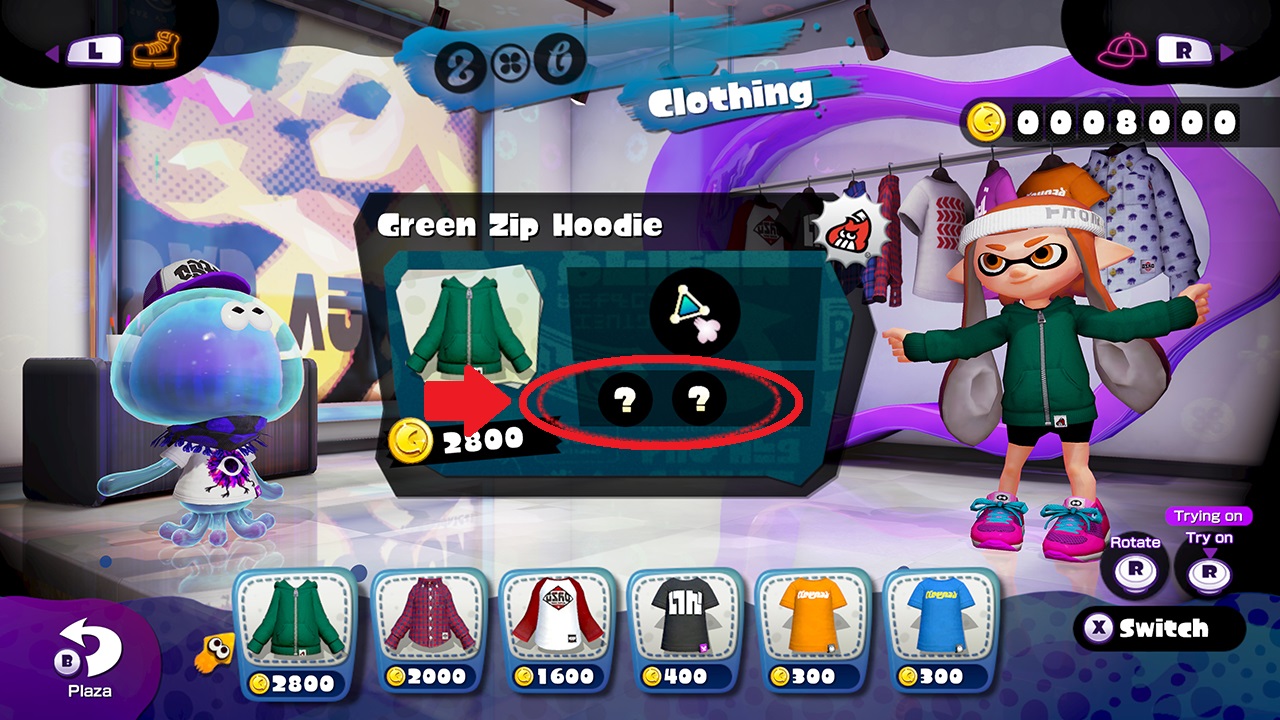
Each piece of clothing has random abilities that you must discover by playing matches with the item equipped.
On the surface this isn’t a massive difference from most MMOs or Multiplayer games. Some games decide to tie aesthetics to special abilities in a game. The key difference that Nintendo makes is that the abilities of a new item are random. When you buy a new piece of clothing, only one perk is shown. The remaining perks are slowly discovered the more you play with the item.
The result is that this system feels like each piece of clothing is like a trading card booster pack — that you slowly open the more you play the game.
This means in theory buying multiple of the exact same pair of shoes can result in different perks awarded. This system results in players opting in to grinding for the gear that both looks good on their character and has the abilities which work well with their play style. This combination makes for a very powerful long term retention driver.
The 2 key reasons that make this system work:
There is no right answer
What’s important about this system is that the abilities are designed and balanced properly so that there is no set of abilities that dominate over all others. A must in any skill-based PvP game. Each ability benefits different play types equally.
Because there is no dominant play style, players are more likely to experiment. Players naturally will experiment with different perks, seek out cooler clothing, and as a result opt-in to playing with a ton of clothes that they normally wouldn’t bother with. Just in efforts to discover new abilities and experiment with different perks.
Just like Hearthstone, or any game with a strong meta-game balance, there should not be a dominant strategy. The more intrigue that goes into players debating over the optimal strategy, the more likely that players at the high level will be happy to experiment and try out new builds.
The clothes don’t give everything away from the start
Nintendo could have simply shown all abilities on the item from the point of purchase. Because they chose both to hide the abilities and force the player to play to discover them, they created a strong drive to keep playing.
F2P designers should seek to find similar systems in their own games. In any loot-based game or gacha-style system, do you need to give away all information about an item from the start? Can you ask the player to play before they discover any special abilities?
By asking the player to play instead of immediately get the benefit, you’ve asked them to invest in your item. Just as psychology teaches us, by making the player work for the benefits, they are more likely to find higher value in the outcome.
They will be more likely to “grind” (level up) multiple versions of the same item to get the benefits they want. They will be more likely to feel really smart when they’ve lucked out and found an item that randomly had a unique ability. This will build investment in the player and drive a long lasting metagame.
As a result Splatoon’s meta game is a longer lasting system than Call of Duty’s, despite having less perks, less guns and more casual gameplay.
#2 Special Order Queue
The second interesting system in Splatoon is the clothes ordering queue. Now that you know why clothes are important and why players happily grind for them, there’s an additional system which drives players back to the game.

Players in Splatoon can walk around the lobby area and see different avatars from around the world. You can walk up to anyone and see their clothes, which perks are on them, and how cool they look. This is a good system for driving desire (“I want that hat! With those abilities!”). Nintendo doesn’t stop there though — it also allows players to order clothes they see from other players. So if you really like that hat, order it!
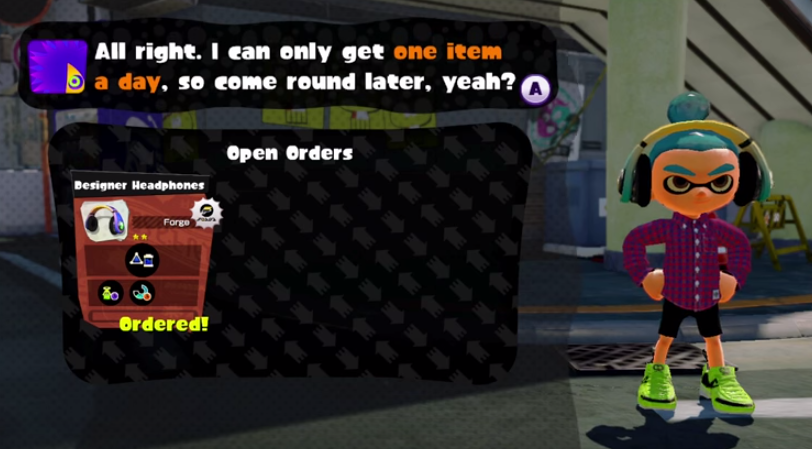
Your queue is only filled once per day. Spyke will retrieve the item for you, but with some hidden abilities.
But ordering is not immediate. Instead Spyke (a character which you order from) needs some time to get the item. To order you have to add it to your queue. An item from your queue is delivered once per day. When that day is over, if you haven’t purchased it, the item is gone. The next day you return the next item in your queue is available.
So this means:
- You as a player opt-in to coming back tomorrow to buy the item (or the days after depending on your queue)
- The rarer the item, the more likely you are to commit to returning
- When you arrive the following day, you’ve committed to purchasing this item within the time limit. You ordered it!
- If you can’t purchase the item by the end of the day, then only you are to blame. Pushing players to create a goal to play enough to purchase the item within the time frame (“I only have today to buy that cool hat! I have to get the coins!”)
- If you don’t come back to the game at all that day, the item is lost off the queue. Again, only you are to blame. You opted-in to this purchase window.
This system is interesting for free-to-play for 3 reasons:
Using the daily pacing feels natural: There’s no timer in my face, yet still paces the player. Daily cycles feel more natural to a player compared to a long timer (ex. “come back in 24 hours!”)
It builds commitment in the player: The player is now committed to come back to purchase the item, and to play the game enough to be able to purchase the item in the time it is available.
Punishment is fair: The player completely opted-in for this restriction, making the player more likely to accept the punishment if they fail. This also means that they are more likely to spend to avoid the punishment (“It’s my fault! but if I just pay $x I can avoid the punishment…”)
These 3 ingredients make for a very compelling F2P mechanic for both retention and monetization. This can be applied to any game that has a wide variety of items and gear to give away. Characters in Contest of Champions, Gear in Fallout Shelter, or maybe even cards in Hearthstone. Having an order queue which is filled on a daily basis can be a strong daily session driver. It drives strong commitment, feels natural, and feels fair.
In Summary for Splatoon
Splatoon is a very interesting game. If you have a chance to play it, I highly recommend it.
Besides the usual Nintendo charm, Splatoon managed to inspire me with a couple very interesting F2P systems:
- They drive me back to the game to find the best clothing and abilities
- I’m committed to come back to the game and play a few rounds each day to pick up my orders for clothes
These 2 key systems that can be applied to many F2P games to drive what’s most important: long term retention.
Deconstructing Hearthstone by Blizzard
Blizzard’s Hearthstone has defined collectable card games (CCGs) on mobile over the past year, and with the recent launch of the versions for smart phones on both iOS and Android the mobile revenues have rocketed roughly sevenfold.
Hearthstone is an interesting game to look at, because it breaks so many of the conventions of mobile F2P:
- It has no energy system
- It sells only permanent items
- It is highly skill based
- It is mainly synchronous PvP
As such it appeals to a lot of self designated “gamers” that find other mobile games somehow below them. This run down of the game will take apart the main features and discuss how they create and great game, and whether there are larger implications for the mobile F2P industry.
Core Loop
The core loop in Hearthstone is incredibly simple:
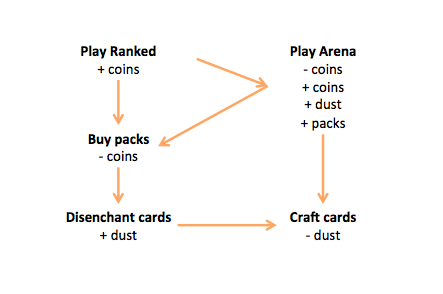
There are two main play modes: Ranked and Arena.
Ranked can be considered the basic game mode, where players play against each other synchronously to climb a monthly ladder. Players use decks that they have constructed from their permanent card collections. It is free to play, and players earn coins for winning matches and completing quests that appear daily.
Arena can be considered a secondary play mode, but is hugely important to and complements Ranked play. Here players also play synchronously with each other, but they must pay an entry fee – either coins or real money. Players make a deck as they enter the arena, choosing one of three cards at a time until they have a full deck. The rewards depend on a player’s performance, but can be generous compared to the entry cost.
The balance of the two modes is important, because it provides both payers and non payers, as well as players of different skills something to do. Earlier on, players may find Ranked play easier as they learn to put together decks that rely on specific combos. Later on they may find Arena more fun as there is the challenge of putting together a deck on the fly, and all players have the same chance of getting legendary cards.
Pacing
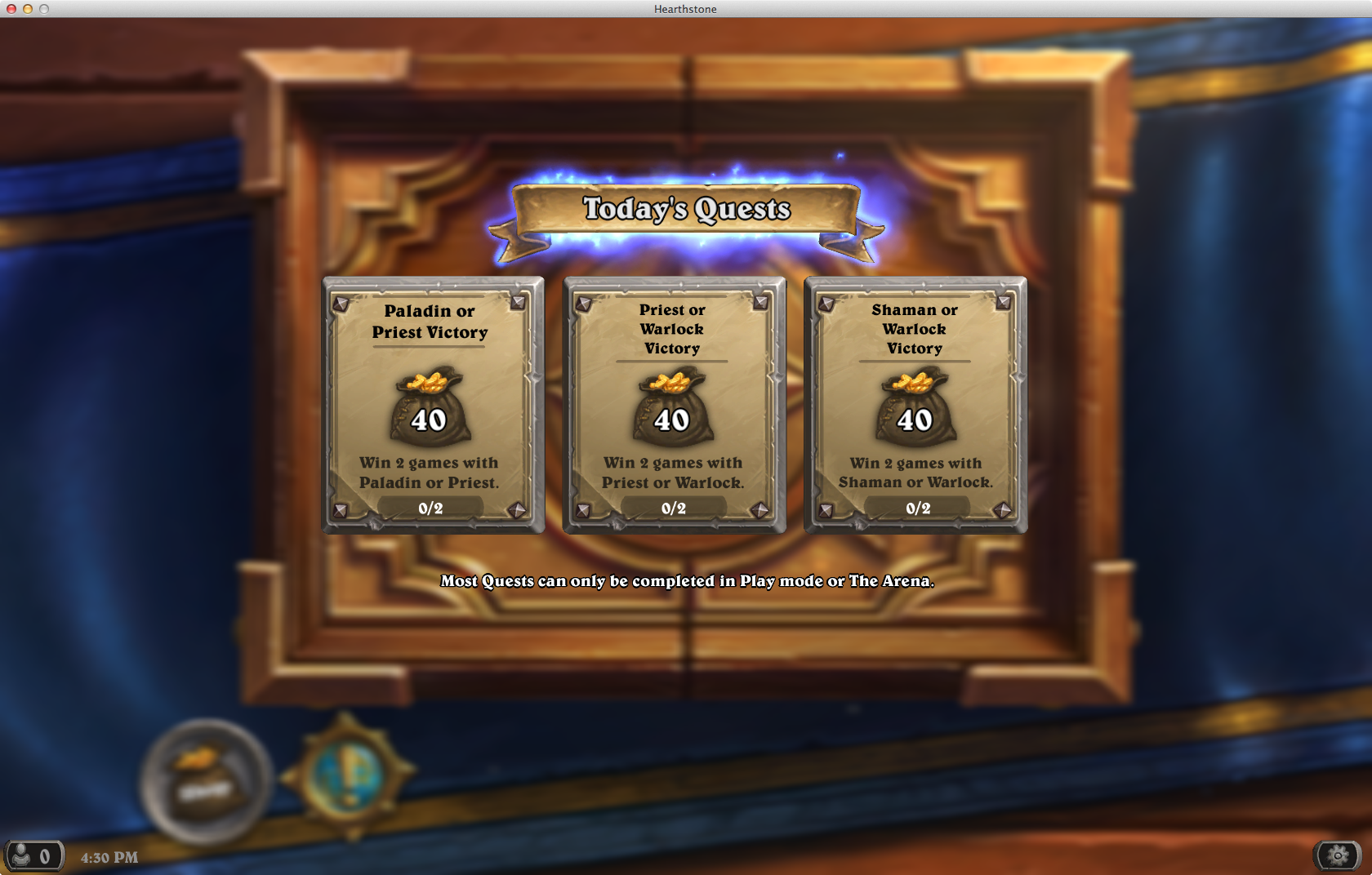
Quests act as the pacing system in Hearthstone, but it is so well framed that many players don’t see it for is. Rather than restricting the number of matches that players can play in a certain time, quests limit the amount of coins that a player can earn. Players get one new quest each day, and are limited to having three in total at any one time. Players can earn small amounts of coins for winning matches in Ranked play (10 coins every 3 wins), but this is small both compared to the time it would take to play these matches (perhaps 30 minutes or more on average), as well as the coins earned from quests (40-100 per quest).
As players earn most of their coins from quests, and not from playing matches, Hearthstone has no need to limit the amount of times a player can play. Players can (and do) sink hours into climbing the rankings without breaking the economy, as after the first few games their in game earnings are virtually nil. This is such a simple yet effective feature I am amazed that more F2P games have not copied it – energy systems are by far the most hated, yet standard F2P systems.
Single currency, single resource
I count coins as the single currency in Hearthstone and dust as the single resource. Hearthstone does not have a soft currency for everyone and a hard currency for payers. It follows therefore that it does not have items that can only be bought for hard currency. Purchasable things in the game can either be bought for either coins or real money. Dust is reserved exclusively for crafting specific cards.
The fact that as a non payer you can get anything in the game, and you can earn coins at a reasonable rate, helps create an environment that seems fair and inviting for both payers and non payers alike. Whilst the temptation to drop real money on a bunch of packs is constant, it never feels like someone has beaten you just because they’ve spent money on the game.
Permanent purchases

The nature of card rarity in Hearthstone also supports the feeling of fairness. Cards have one of four rarities: common, rare, epic and legendary. However, in contrast to many of the other mobile CCGs, cards cannot be upgraded or fused. This means that buying cards always results in a permanent addition to your collection, either directly or through the crafting system.
As with all CCGs there needs to be some method of dealing with duplicate cards, to maintain the randomness of pack opening. Hearthstone only allows players to have two of each card (one of legendaries) in their deck. Duplicates beyond this can be disenchanted for Hearthstone’s main resource: dust, which in turn can be used to craft any card in Hearthstone. The conversion rate is obviously not great – cards give only 25% of their cost to craft when they are disenchanted, and making progressively rarer cards gets ever more expensive. You need to disenchant 320 common cards to craft a single legendary. But the system does mean that even if players only get duplicates through randomly opening packs they can work towards specific cards that they want to create particular decks.
The fact that purchases result in permanent items that cannot be taken away from the player makes them all the more attractive. Players know that if they get a legendary card they will always have it, and its power will stay constant. Players can still spend huge amounts of money on the game, as there are so many cards to collect and the chance of getting a legendary is so low. Various Reddit posts put the cost of a Legendary at around $12-24, so with 67 legendary cards currently players could easily spend over $1,000 getting all of those alone. The cost of the epics and rare cards would be on top of that, and players can pay 4x for cards with a gold back – a purely cosmetic change.
Buying Experience
[youtube https://www.youtube.com/watch?v=_N0p4YSXn4Q]
The permanence of purchases together with the overall polish in the game creates an incredibly positive buying experience. You would expect nothing less from Blizzard of course, but the pack opening sequence is spectacular, especially when compared to the drab experience in many mobile F2P games to skip a timer or add more resources. Buying something feels great, a detail that is all too often overlooked.
Skilled play vs. Pay to Win
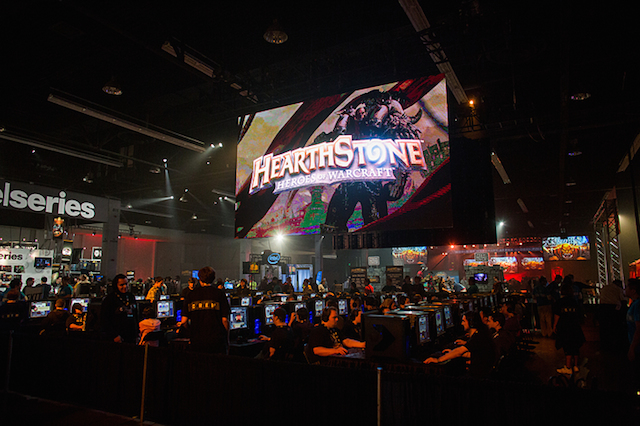
Most mobile F2P games steer clear of including too much skill. Skill makes games more difficult to balance, as players will have a varied experience of the same content. Furthermore, with highly skilled games it is difficult to give players a continuous sense of progression, as their skill level will typically plateau after an initial learning period. As most mobile F2P games are selling progress, they need to maintain the sense of progression that grind based games give, as ensure that players have broadly the same experience by leveling the playing field with luck.
In contrast, Hearthstone has a high degree of skill – the game has an impressive number of tournaments and events, and Blizzard host a World Championship at BlizzCon that had a prize pool of $250k last year. Youtube and Twitch are awash with Hearthstone matches and the top players are starting to make their fame and fortune from the game. This is clearly a far cry from games like Clash of Clans or Game of War, where success largely depends on the amount of time (and money) players can grind into the game.
That said, in Ranked play, working your way up gets more difficult the higher you go not only because you meet more skilled opponents. Any player will tell you that you need to both have the right cards to put together in a deck to create the right combos, as well as the ability to change your deck as you go. This flexibility is vital as the meta game changes as you move through the ranks. At a given time, rush decks might be unstoppable at ranks 20-15, but easy prey above rank 10.
Always having the right epic and legendary cards to finish off your deck becomes essential, but you rarely need very many of them to create a good deck. The pressure to spend is in having the necessary breadth of cards, rather than a deck construct solely of very rare cards. This creates a dynamic where players do need to spend to play at the highest levels, just as League of Legend players need to practice with all the different Heroes rather than just the ones that are freely available that week. At the same time each individual card is balanced for its mana cost and players who have spent a lot of money to acquire a lot of different cards might be beaten by a player who has spent very little, but happens to have the right cards for that particular battle. Players must spend to progress in general, but matches don’t feel pay to win.
Synchronous PvP
Hearthstone is one of the only successful mobile games to centre on its synchronous PvP experience. Vainglory and others have tried to take this challenge on, but no one else has succeeded except another game backed by a massive desktop IP: World of Tanks Blitz. Hearthstone was in beta on PC 9 months before coming to iPad, and had half a million downloads before it even hit the App Store. This period was essential to give them the critical mass needed to match players with each other at an appropriate level. Without it players would either be facing long wait times every match they played, or getting matched against players of very different skill – either case is a potentially game breaking experience.
Blizzard’s ability to drum up this level of interest in a new game is a testament to their expertise at launching new synchronous PvP games, but absolutely not a reference that other developers can hope to emulate. Without Blizzard’s existing World of Warcraft IP, installed fanbase, community management efforts and PR, the game would have faced a much harder prospect of building the community necessary for critical mass. I do not believe that we will see a synchronous PvP based game successful on mobile without a PC version any time soon.
Conclusion
The success of Hearthstone, combined with how different it is from many other mobile F2P games makes you expect it would have a huge impact on the prevailed design trends in the industry. The pacing system in particular seems superior to the energy systems that are still prevalent in many games. However, the fact that Hearthstone was launched PC first on the back of the huge World of Warcraft brand has allowed a number of other differences that the vast majority of mobile F2P developers cannot hope to emulate.
Deconstructing King of Thieves
Let’s take a deep dive into ZeptoLab’s latest game King of Thieves. Launched in February 2015, this game has piqued my interest. While not on the top spot yet, the game’s bold design deserves a look.
In my opinion, this is a game that deserves to be successful. It feels unique and has all the elements that make up a top grossing game. ZeptoLab has taken what works in simulation and strategy games, and applies this to a totally new genre and a completely new target audience.
This approach is what I feel more new game designs should do to be successful on the AppStore.
The Pitch
The pitch for King of Thieves is “Super Meat Boy” combined with “Clash of Clans”.
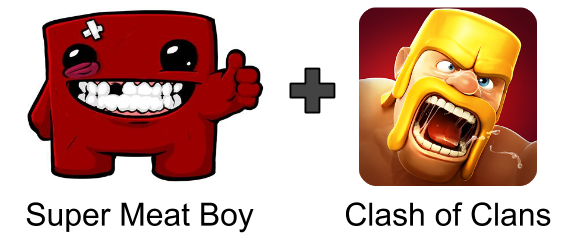
The core gameplay is a one-button platformer. Your Thief (the little cute black shadow) automatically runs left or right. You can tap to trigger a jump in the current direction. You can also jump off walls to reverse the players direction. ZeptoLab has managed to give classic platformers a mobile makeover. With one-touch controls it feels native on mobile. With simple rules, it feels expressive and gives players plenty of options. The gameplay is simple and is very transparent about what you did wrong each time you die. This creates very addictive core gameplay.
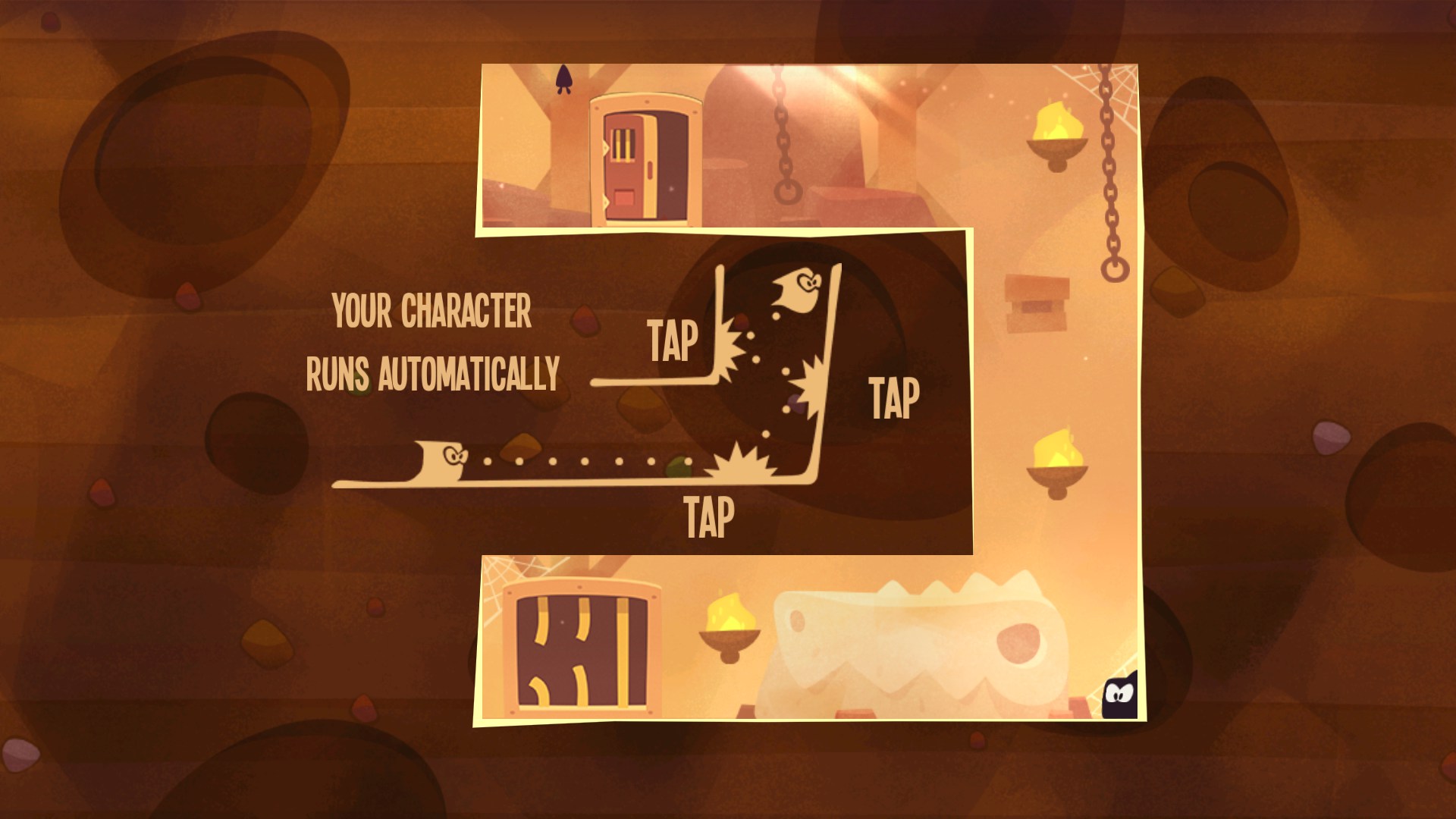
The object of each level is to reach a treasure chest. Go from “point a” to “point b” by avoiding traps. Hitting a trap will reset your progress right to the beginning. This punishment gives the game the “Super Meat Boy feel”. Reasons for losing are always clear to the player, and there is very little friction to restarting. The player jumps back into the action as soon as they are killed, making it extremely addictive to just keep trying to beat a level.
The meta (the progression systems outside of the core platformer gameplay) is a re-hash of Clash of Clans. They’ve managed to modify the standard Clash of Clans formula into something that works very well with the core platformer gameplay. Just like Clash of Clans, King of Thieves asks the players to manage two layers of gameplay: attacking and defence. On attack, the player plays platformer style levels to steal gold and gems (more on this later). On defense, the player must design a base that defends against other players’ attacks. Players sessions are focused on stealing as much loot from players around the world to upgrade their own abilities.
The Session Loop
To deconstruct, I’d like to focus on session design. To do this, we need to break down the game into its daily action loop: the repetitive actions the player takes to progress in the game. Let’s evaluate each step in regards to how it impacts the way the sessions feel.
Looking back at the post on Flexible Sessions, the key principle of designing sessions is about creating a diminishing curve of value for sessions per day and for session length. Just to reiterate: The first rule is that the first session of the day should feel more impactful than the 2nd, 3rd, or 4th time the player returns. By the 5th+ session, this should give minimal value to the player. The second rule is that session length should also have a diminishing curve of value. Eventually a player should naturally feel that returning at a later point in the day would be more beneficial. These two rules make up strong session design.
So how does King of Thieves execute this?
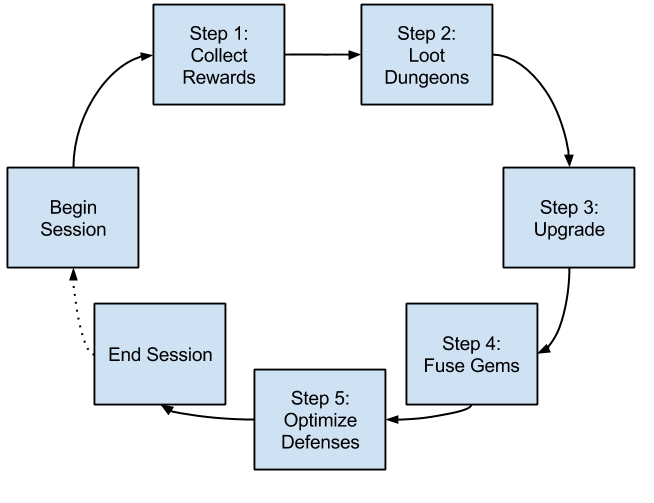
Step 1: Collect Base Rewards
Each day the player begins their session with collecting the rewards from their dungeon:
- Collect gold from their stash. (Optional Short Timer)
This is a bucket-filling mechanic. Allowing players to collect from the stash as many times as they wish throughout the day.
- Collect gold from successful defences. (Short Timer)
Making sure players feel good about their defences, players collect gold for every failed attempt by other players in their dungeon. While not a lot of gold, this certainly feels good when you’ve come back after a long absence
- Collect generated gems (Long Timer)
Gems generate on the map on a longer cycle (multiple hours).
You can see here that these three reward cycles each have varied timer length, which allows for strong session design. Short timers to value coming back more per day, but longer timers to reward daily play. Using rewards of varying length, the player has a clear diminishing value for returning multiple times throughout the day.
Step 2: Loot Dungeons with Keys
After the player has collected all their rewards, they want to maximize their cash for their current session. There is always the threat that other players in the world will steal any resources they have when they leave the game.
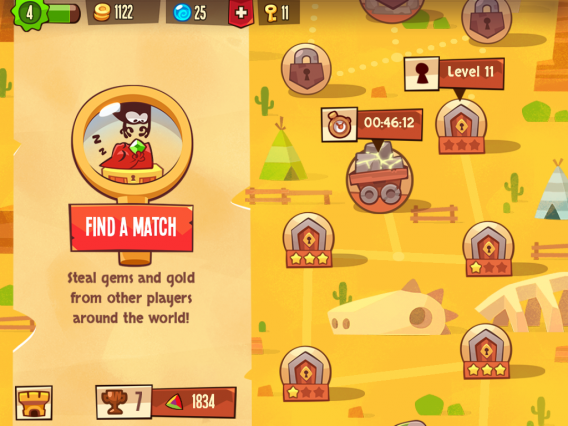
Players can choose between the PvP (left) or the PvE (right)
To do this, players loot other player’s dungeons (PvP levels) or designer-created levels in a map (PvE levels). Player-created levels hold high value gems. Whereas the PvE levels have higher gold rewards (sometimes), unlock new gem generating mines and new dungeons which the player can move to. This system works because both PvE and PvP benefit the player in different ways.
King of Thieves innovates with their pacing mechanics. Instead of using energy or lives like in most games, they use “Keys”. Keys refill like in most games with time. The key difference is that the amount of energy (or keys) the player needs to spend to enter a level is randomized.
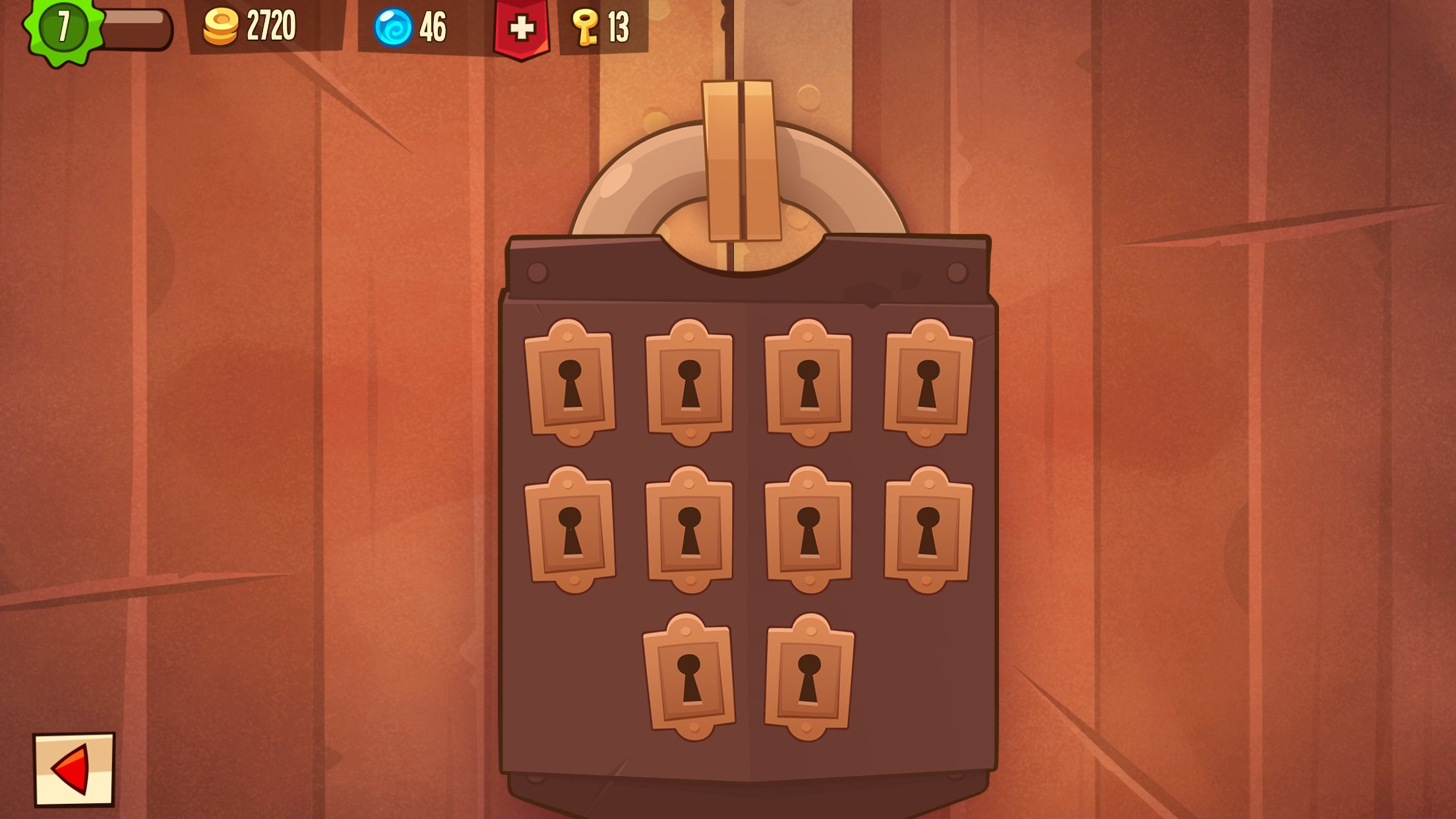
Players can choose a lock. Each attempt costs a key. Only one of them gains entry. Randomized Energy.
The player chooses locks on a screen with their keys. If they get the right key, they enter the level. If they choose the wrong one, they must spend another key. The game supplies the player with more than the usual amount of energy (10+). However, some levels can use 1 key to enter, others up to 15 keys to enter. Why would ZeptoLab design a system like this?
This system doesn’t please all player types. I’m convinced ZeptoLab benefits more from this system than the player experience. Not an easy choice I’m sure as a designer, but these sacrifices are sometimes necessary in a free to play game.
From the onset, this system feels arbitrary, just like an energy system. The player’s ability to loot is capped by some tacked on economy. Compared to Clash of Clans, Clash’s pacing mechanics make sense: you will eventually run out of troops to loot opponents. King of Thieves just says you run out of “keys”. Could this be fixed if the player had to “craft” keys in their base? Could this be fixed if the player had to build clones of their shadow player to start looting? Maybe. Overall I’m not a fan of the system, but I understand the benefits for ZeptoLab.
Because the system is randomized, players can try for one more level even if the player only has 1 or 2 more keys left. If they get lucky, this feels great. They get to play the level with little cost. If they fail, they are presented with this screen:
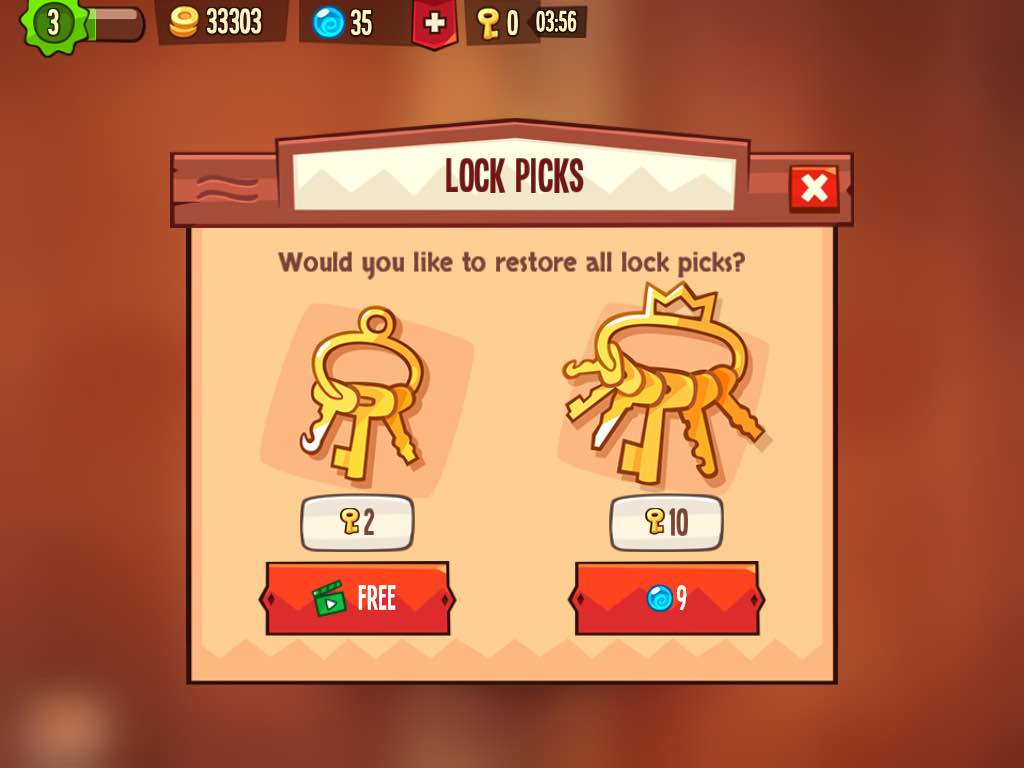
This screen is a high conversion screen for their video ads. Want to keep trying? Watch a video ad. Video ad revenue is becoming more and more interesting in the mobile free to play space, and I completely understand why ZeptoLab wanted to create a pinch point for this type of system. Players then binge watch some videos to get in that “just one more play” feeling.
On top of converting players with video ads, this type of randomized energy system also creates a nice way to balance harder and harder levels. Players can upgrade their key storage limit to be able to reach higher and higher levels. The higher the level, the more locks that the player must attempt. Also, this can create an interesting session per day value curve. ZeptoLab can use metrics like sessions per day and session length in their decision about how lucky the player is. This may be dubious, but this type of “invisible hand” to guide the session design can be very powerful.
In the end, I’m unsure if this system of randomized keys was the best choice for King of Thieves. The system is a unique design and I’m excited to see what the market thinks of it. Just based on the conversion to video ads, I think this could be something to try for other genres.
Step 3: Upgrade Your Base (or Else!)
After the player has looted as many dungeons as they could in that session, they may use their found coins to upgrade their dungeon and resource generation. Any coins left over will most likely be stolen, so players attempt to spend every coin they looted. This promotes going for one more looting session, or extending the session to purchase more gold.
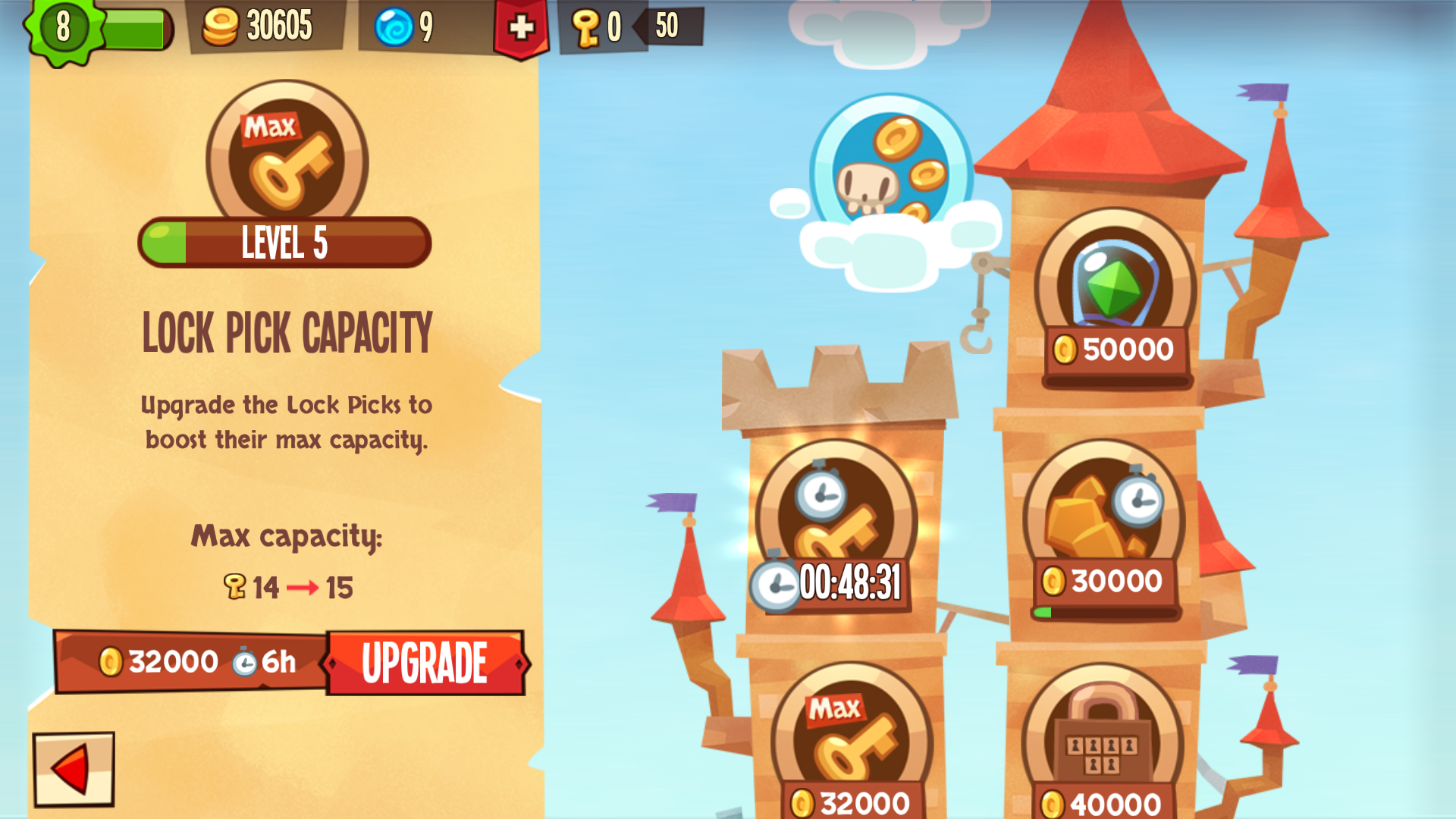
Step 4: Fuse Gems
The key to the meta and progression of the game is fusing of gems. Players collect gems from mines on the world map and by looting other players in the world. The player then takes the gems collected and fuses them in their base.
Fusing usually takes many hours (3+ hours for a usual gem). During this time the gems in this fusing ritual are open for stealing by other players. This is the most anxiety-inducing timer in the game. A gem will be stolen unless they keep the game open or have amazing defences. I spent about two hours on a weekend keeping the game open while watching movies because I was too afraid to close the app and lose my gems.
So why would players opt-in to this nerve wrecking timer?
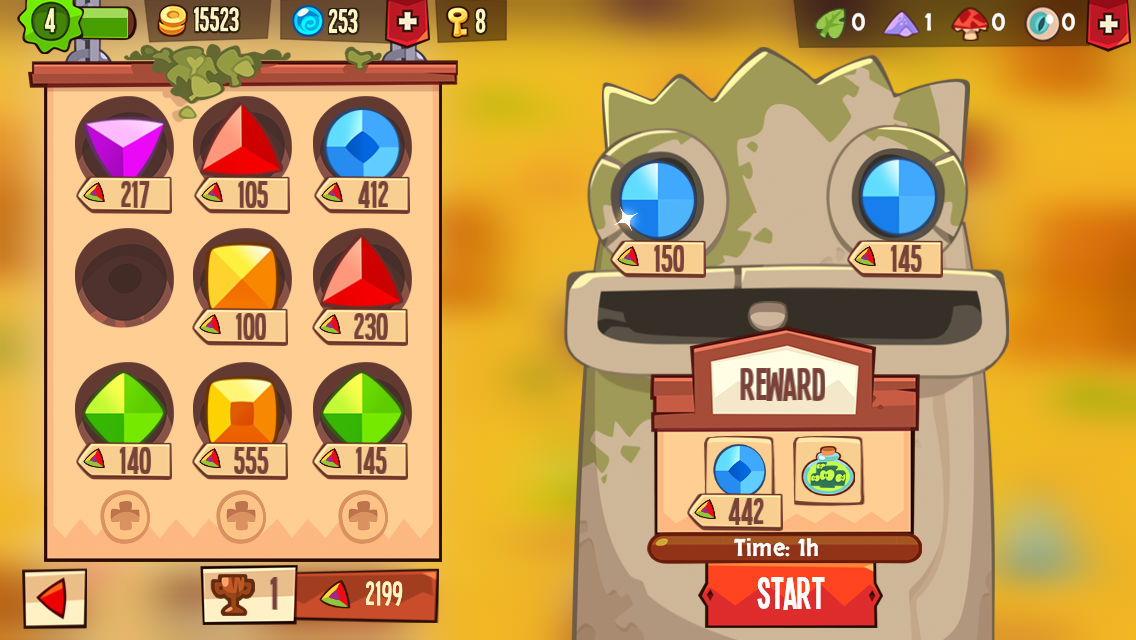
Increasing gem value is the goal of King of Thieves. The total value of your gems is how you rank in the game. Players are looking to retain only the highest quality gems (which is shown by a number). However, there are only limited slots the player can have to hold onto gems. So players quickly run out of slots and are forced to fuse gems together to make more slots for higher level gems.
This was a very, very smart design choice by ZeptoLab. This creates a natural cap for progression and creates a lot of very interesting choices for the player. It also creates an obvious high conversion item for monetization: the extra slots for gems. Similar to the builder in Clash of Clans, ZeptoLab has created a high conversion item out of these extra slots. I’m convinced that if they brought this to the forefront and made it cheaper for first time players, this could be a strong conversion item.
Step 5: Optimize Defences
After they’ve completed this loop: collect, attack, upgrade, fuse… what’s left?
Just like in Clash of Clans, players can extend their sessions by optimizing their dungeons defence layout and adjust the positions of traps. This comes with one caveat: the player must be able to beat their own level twice… in a row.
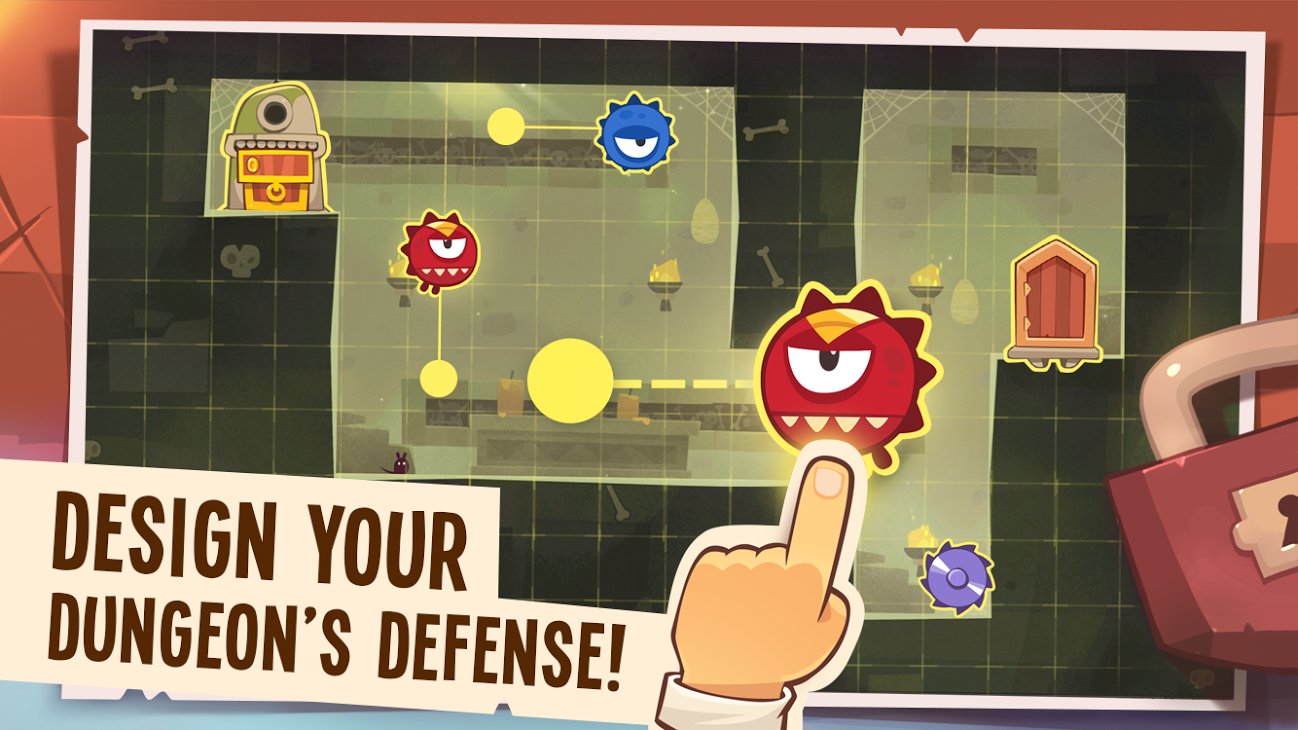
This definitely creates a session extension. I’ve spent well over a half an hour trying to create the optimal dungeon design. All this time was not incentivized by the game, but I wanted the best layout possible. This is exactly what you want to create in your session design. A session extender that players can take as little or as much time with as they wish. The value diminishes over time.
What King of Thieves did right: Social Pressure Mechanics
ZeptoLab shows an excellent example of how to add effective social mechanics to a game. Asking players for help to retrieve lost gems creates social pressure. I feel good about helping my friends, I enjoy when my friends help me out when I’m less active. I rely on my friends to help me optimize my fusing timers. The value of having active friends is apparent.

The league system creates a nice PvP environment with a clear reason to collect gems. Instead of feeling like I’m levelling up just based on some arbitrary number the designer has created for me (ex. collect 5000 gem value in 5 days), I’m competing against a living breathing opponent. I have to be engaged to compete, and the number is always growing so I never feel safe about my position. Sometimes I wish there were ways to specifically steal from other players on the leaderboard you were competing in. This would really drive up the competition.
King of Thieves also uses the same idea of clans in Clash of Clans. King of Thieves wants you to join a Guild. While the system is clearly in its infancy, it shows a commitment by ZeptoLab to the future of the game. Guilds are what will really drive the long term retention, and including it in the global launch was important. The mechanics at this point are still too early, but in the coming months I expect that ZeptoLab will build from this base and make very competitive play between Guilds stealing gems from each other. I hope they find a way that Guild members can work together on a dungeon or a raid. It would also be interesting to incentivize Guilds to put their most valuable gems in a vulnerable position. This will really drive competitive gameplay between the Guilds and give a collective goal.
What King of Thieves could improve: Hardcore Skill
In the translation of the Clash of Clans metagame to Super Meat Boy style mechanics, something fundamental was lost. Because platformer gameplay is inherently so skill-based, the translation still feels like a massive amount of skill is required to win.
Clash of Clans (as discussed before) although it requires some mix of stats and skill, the main determinate to win each fight is Stats. If you have an amazing army, you are going to win. If you have spent a ton of time (or money), you will be able to dominate against an opponent lower than you. As you defeat more of these easier players, you will be matched higher and higher in the leaderboards. This will demand more skill, but mostly more stats. This system allows players to “hover” around matchmade opponents that challenge their skill level, but still require high stats. Even if I’m terrible at selecting where my troops go, I’m still progressing, and I may be lower on the leaderboard compared to other players at my stat-level, but I still am progressing.
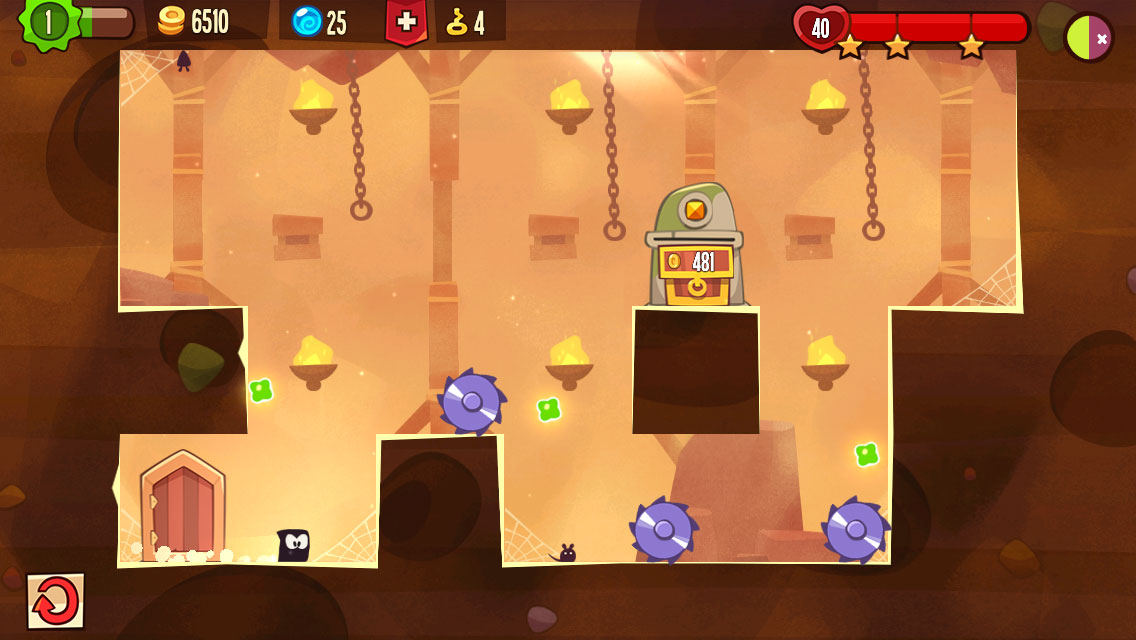
King of Thieves is never flexible over the amount of skill it requires from players. As you progress in the game, it keeps demanding more and more skill from its player base. As a result, the game feels very hardcore. The players that reach the end game are a smaller and smaller niche of highly skilled players. Why does this happen?
As the game progresses, players slowly get harder and harder obstacles they can place in their dungeon. In order to set up a dungeon that is difficult, the player has to beat it themselves. As a result of this system, unless a player is highly skilled, their dungeon, regardless of the defences, will remain at the same low level of skill-difficulty. There is no way for a player to increase their defence without actually being far better at the platforming game.
There are some stats that affect the game: the damage of the obstacles, your shadow’s equipment and armour, the amount of keys you have, etc. But these stats clearly take less of a precedence over the skill. In my opinion, there are some levels that you just need high skill. So as you progress in the game, no matter how much time or money you’ve put into the game, you will reach levels that it doesn’t have an impact if you don’t have the skill. There is no “hovering” in the matchmaking that allows players to feel progress regardless of skill. Players with low skill will feel it: they are punished by losing levels very often.
This is most likely an artifact of trying to combine a high-skill genre (Super Meat Boy) with Clash of Clans. While this pushes away players that are expecting a lower skill level, I think it also engages the highly skilled players even more. The tradeoff between a highly engaged niche target audience and a flexible broad audience appeal is incredibly difficult to get right.
The Results:
On launch, the app was featured by Apple. This drove hundreds of thousands of downloads, but has yet to crack the Top 100 US Grossing. Can it get there? This will be an extremely tough. After a featuring, the only way to drive the necessary volume to reach the Top Grossing Chart is to purchase installs. This is extremely costly.
However, the game supports very strong early day retention and with more work can improve their long term retention. With continual improvements, this game has a chance to reach a stable position in the Top 250 Grossing.
Personally, I’m cheering for ZeptoLab. This design is refreshing. I had the feeling that the mobile free to play space is even more risk-averse than the console/pc space. This feels like a step in the right direction. This is a game ZeptoLab should be proud to have worked on. I hope other game developers can look at this example on how to innovate in new genres










 So while Fortnite’s Battle Pass system may just be in its “early access” phase right now with a basic feature set, it’s clear that Epic is taking inspiration from Valve’s similar Battle Pass system. This evolution shows that the current implementation is not just limited to 100 tiers of content, but could be a far longer lasting and complex chase which could drive even higher retention and monetization. This system clearly has been successful for DOTA2, since recently they’ve started to shift the system to a full-on subscription style service called “DOTA Plus”. Little details are known at this point, but it looks to be replacing the Battle Pass with an ongoing subscription that gives even further systems and progression.
So while Fortnite’s Battle Pass system may just be in its “early access” phase right now with a basic feature set, it’s clear that Epic is taking inspiration from Valve’s similar Battle Pass system. This evolution shows that the current implementation is not just limited to 100 tiers of content, but could be a far longer lasting and complex chase which could drive even higher retention and monetization. This system clearly has been successful for DOTA2, since recently they’ve started to shift the system to a full-on subscription style service called “DOTA Plus”. Little details are known at this point, but it looks to be replacing the Battle Pass with an ongoing subscription that gives even further systems and progression.
 Source: Based on SensorTower Data
Source: Based on SensorTower Data




























